July 10 - 16, 2016: Issue 271
John W. Stone
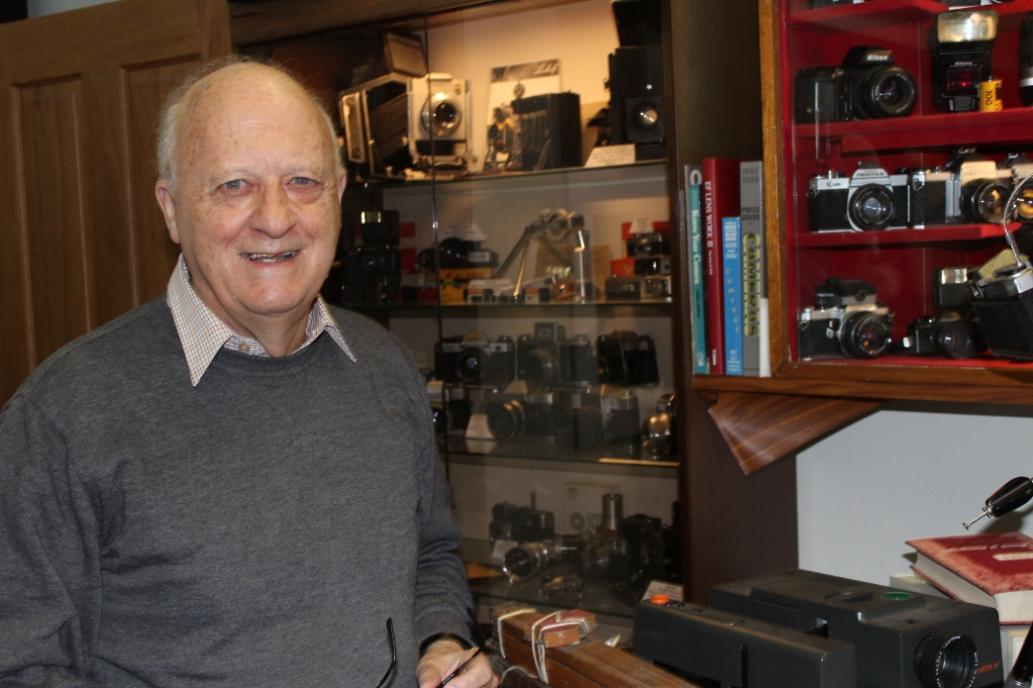
John Stone was the first or second retailer to occupy a shop in the ‘new’ Barefoot Boulevarde’ after it opened in October 1965.
The shop next to the original news agency (at 68 Old Barrenjoey Road) came up for sale and John bought the shop and moved his business there only a few years later.
Although John (and wife Noelene) sold vinyl records, musical instruments etc. John’s main interest was in photographic processing (and to an exceptionally high standard).
Each negative was assessed and the print adjusted accordingly (no massed ‘spit-em-out’ here).
Although the Avalon Beach Historical Society began in 1983 it wasn’t long after that we sought John’s expertise. John reproduced original photos loaned to the Society to help with research and add to the collection. Of course in those early predigital days 35mm black and white negatives were the way to go and from them were printed the 10 by 8 image on photographic paper.
John’s existing photographic expertise was extended even further when he took on the advent of digital photography and now he not only reproduces but ‘improves’ original poor quality, faded and torn images digitally with some outstanding results - “as long as there is even a trace of an image” it’s fascinating what can be achieved.
John became our inaugural Life Member in 2001 for his outstanding work for the Society.
John downsized his office in 2012 and moved into 15 Bowling Green Lane where he continues his restorative photographic work while generously providing space at the front of the shop to ‘house’ the historical society and provide ‘rotating' photographic displays from it’s collection.
Geoff Searl
President
Avalon Beach Historical Society
John Stone is a soft spoken gentleman and easily one of the most humble people you will ever meet. For decades his own photographs, a medium he has a lifelong passion for, have captured the people and times of our area. He has seen the changes in equipment and photography processes and has a wealth of knowledge he continues to update to make the best out of the new and apply it to making the best out of the old. A simple example of this would be the restoration of some of his own images he has kindly shared in this page which caused us to find out about new Programs and how old photos can be 'layered' to improve their quality. A clear case of an Elder teaching a Younger about their own medium!
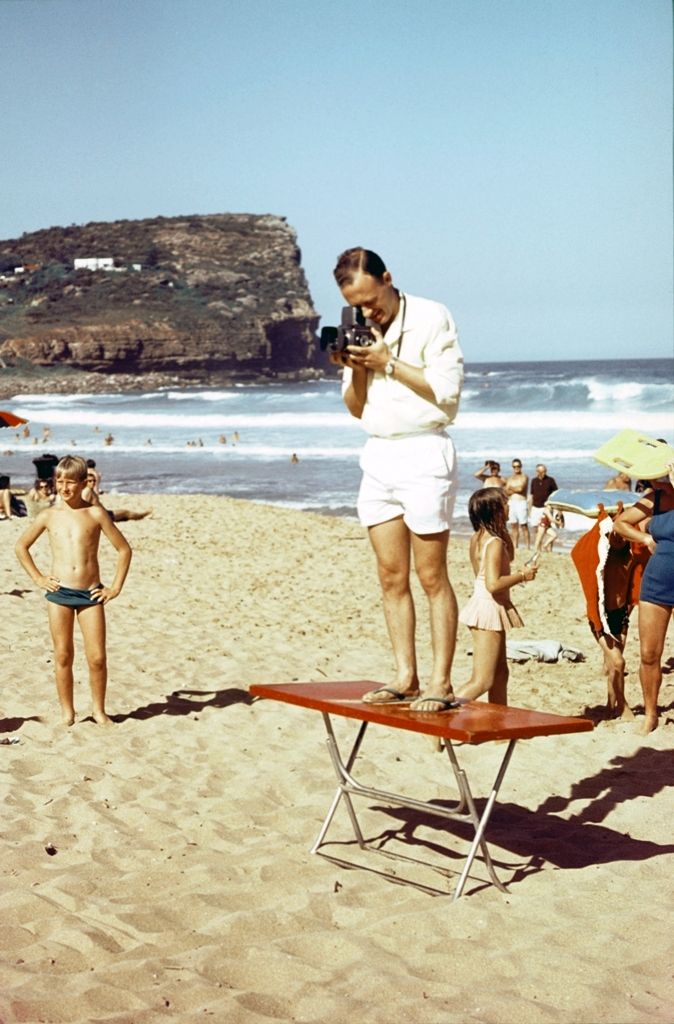
John Stone on Avalon Beach photographing an Avalon Beach SLSC Carnival - early 1970's.
John says some of his own favourites among the many he has taken are about people, about capturing pathos - where you can not only see what is happening but feel something more about those people and what is happening. Photography, after all, remains a medium where a picture is worth ten billion words...
When and where were you born?
1940 in Strathfield, Sydney. I grew up there, my mum staying there for 60+ years.
STONE-January 29 at Siesta private hospital to Mr. and Mrs. Herbert Stone of Strathfield –a son ( John William ). Family Notices (1940, January 31). The Sydney Morning Herald (NSW : 1842 - 1954), , p. 12. Retrieved from http://nla.gov.au/nla.news-article17656127
What changes have you noticed between the Strathfield of your childhood and what you see now?
It was all fields, we had paddocks out the back of our home in Birnam Grove and played in those; great fun. We had little groups of friends where one street would be against another street, but all play together happily. We’d make cubbies in the grasses.
Where did you go to school?
Wadham Prep School, Strathfield, then Trinity Grammar School - Strathfield and then Summer Hill. I enjoyed attending it, playing in the sports team and Cadets, as we had in those days.
What did you do when you left school?
I went to ATN – Channel 7 where I was doing Film Processing for the News, Quiz shows, things like that.
Is that where you love of film and photograph started?
No, it’s why I was there. I took the job because I was interested in learning more. At school I wasn’t in the photography club but I did help a teacher film the building of the chapel at the school so my love of making movies or capturing things on film began with him.
Dad was also keen on photography, hopeless at it, but yes, loved it too. He had all the cameras and the bits and pieces to go with them. He had a Contaflex which had a fixed lens. He’s the only person I know that put a roll of film in upside down.
What was it like being at ATN 7, early days for them?
I was 17 and went straight in as a Laboratory Assistant and they did a film at the end of their first year, in which I appear. This was them filming all the staff and I had been there two weeks! I remember seeing that film again recently when they were showing it to celebrate an anniversary of the station and seeing myself in there still, always gives me a chuckle.
It was a good experience. I worked there for about two years.
What was the most interesting part of this for you?
The whole thing really. In those days you all worked together. Technically I was in the Film Processing department but helped out elsewhere. I remember putting the station on air on Christmas Day and also helped out in what they called Kine Recording, which filmed the shows such as those with Jack Davey and Bob Dyer. Shirley Abicair was one I liked, she was lovely.
I also got to work in the Audio department, which was where we prepared the audio to go with the video – they were two separate setups. Telecine, which controlled what was going to air, was a room room just next door to us, so we’d have time in there helping them load up the films and get them going. This was all just standard then and seemed like nothing special at the time, but looking back it was a challenge to meet all these ways of doing things and so much has changed.
While I was there they changed from film to video tape. These were Ampex machines, using a two inch tape to do the recording. This was like a video recorder. So that’s one historical change I witnessed – if anything went wrong (tape jam or break) the room would just fill with tape! (laughs).
It was all good fun !!
What did you do after that?
Dad had a business and had always been wanting me to go there. Eventually he wore me down and I went there for a while. This was a timber business, Hebert Stone Pty Ltd., at Bankstown; he made timber mouldings, picture framing, architraves.
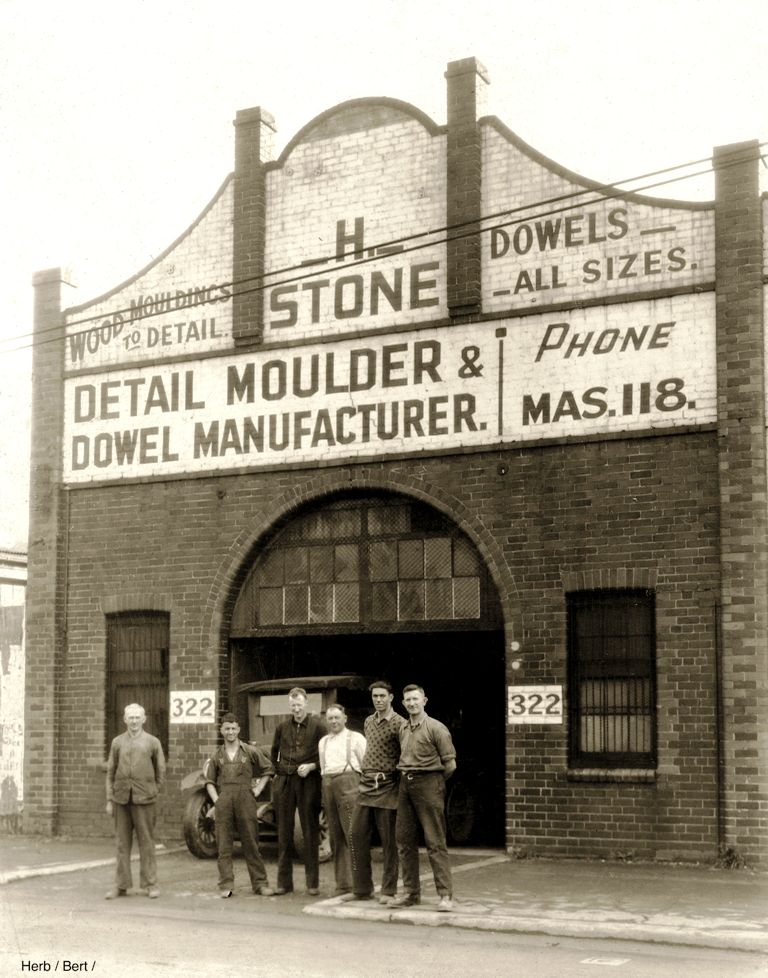
Photo: Herbert Stone Pty. Ltd. - First business at Alexandria - Herbert Stone is second from left.
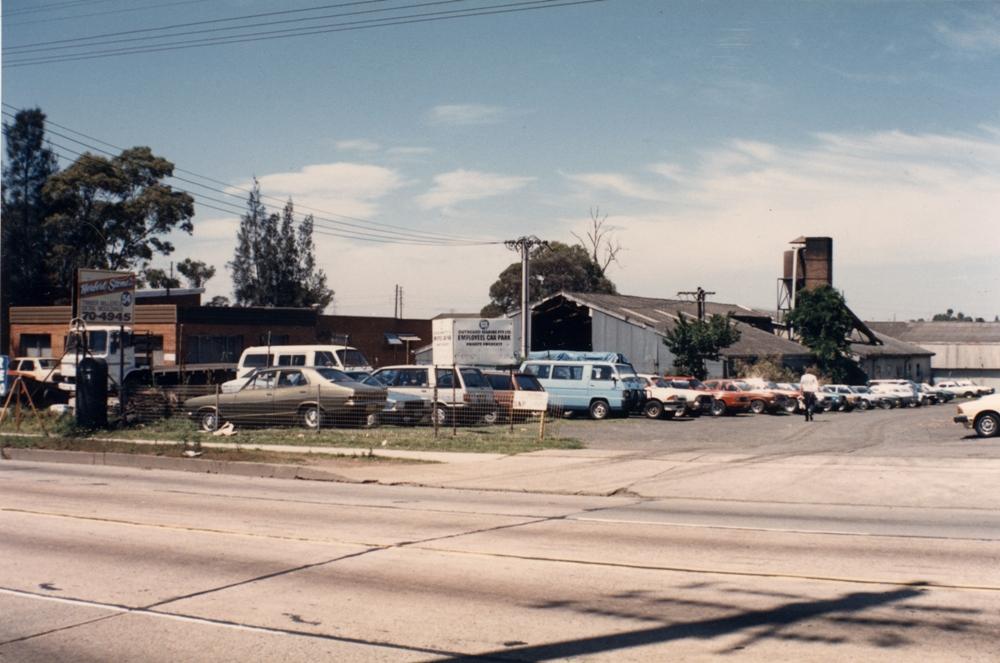
Photo: the Bankstown Herbert Stone Pty. Ltd.
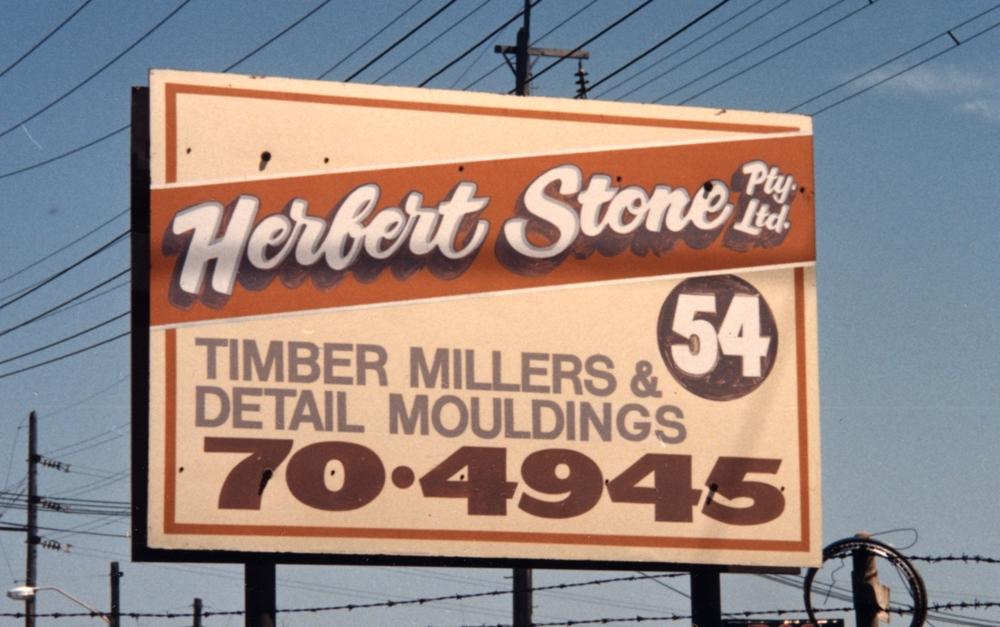
I was only there for a year or so as I kept getting involved with doing photographs outside of this business. I fond a job with a home portrait studio, taking children's photographsand finished up doing the whole gamut; Door to door selling / photography / photo sales / delivery.
Dad gave up eventually and said ‘come on then, we’ll find someone to help you open a shop’.
We had a neighbour David Bleakley, who was a wholesale camera distributors in Ashfield, Swift and Bleakley. These were big photographic distributors and helped guide me with the setup. We opened at St Ives; I was wanting to go in as a photographic shop but they wouldn’t let me so I had to take on the audio, which was records in those days, and we handled musical instruments and sheet music and all the accessories; strings, reeds, everything needed for the instruments.
So this was the first John Stone shop?
Yes, John Stone Photo and Records, at St Ives. This was a new complex then.
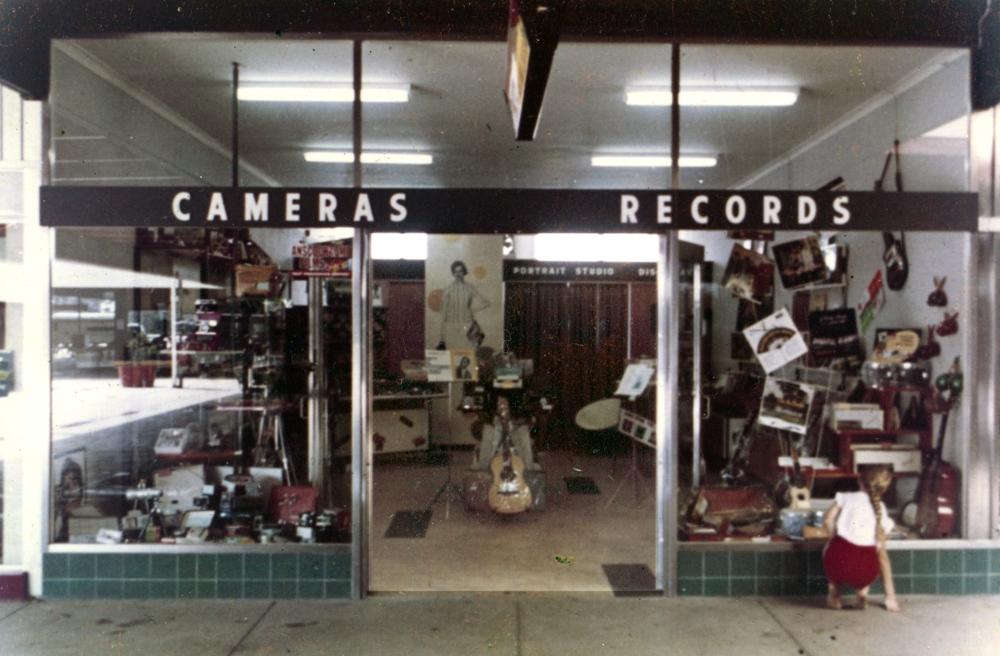
John Stone Photo and Records, at St Ives. The 'poster' you can see mid centre is one John created for the first business by projecting the image of this model, a girl from Strathfield, onto the paper along with the record and musical instrument she holds. 'This was then developed in our bathtub, the only basin big enough at that time to do this in. I called this process 'Bathtub Developing'.'
What photography were you doing then?
I went around doing the horses, doing Horse Jumping Shows. These were all over Sydney. I remember doing one down Narrabeen way at this time too. The St Ives Showground was popular. We went out to Liverpool and Camden a couple of times. That was only of a weekend, I was in the shop during the week.
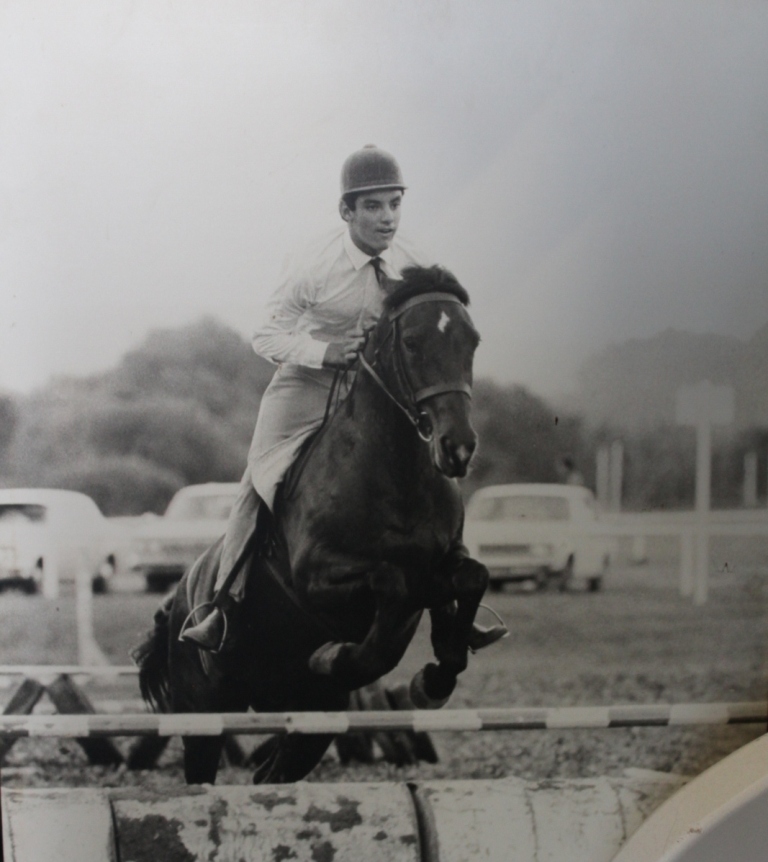
One of John's earlier Horse Jumping photographs.
You have taken some wonderful photographs for decades, not just landscapes and events, but many of the pictures we have today of buildings and places gone are yours. Were you aware while doing this what you were doing?
No. that’s the maddening part about taking photographs. When you start you’re there to do your work and nothing else, you don’t think about turning around and taking a photograph the other way, to show what’s there, for historic purposes.
How long were you at St Ives?
Around four or five years. It was 1962 that we opened up there and then in 1964 we came down here full-time. I was the second person in the Barefoot Boulevard building when this was first built, when that was in its original state. The premises at St Ives was good but the lease worked then that they took a percentage of your takings, not your profit mind, your takings, so you were always going to be striving to make it better and I realised that wasn’t a good way to do business.
Down here in Avalon Beach there was a Radio Shop in Old Barrenjoey Road run by the Bonningtons, and he was closing down. His shop was where the cake shop used to be and near where Plunkett’s pharmacy once was. He stocked a few records, not many. When he sold out, he sold the rights to sell records to another radio shop owner, Mr. Dykstra, which I didn’t know about.
The record companies at that time wouldn’t allow two record shops in the same vicinity; you had to prove that the sales could be enough to warrant stocking their records, which down here we couldn’t. When I opened up there was a bit of screaming for a while from the companies. I used to have to bring the records in to the St Ives shop and then transfer them down to here. So I had to keep both shops open for 18 months. After that time I was able to sell the St Ives shop; they felt my shop was doing a much better trade.
The second radio repair shop, the Dykstras, kept selling a small stock of records for quite some time though.
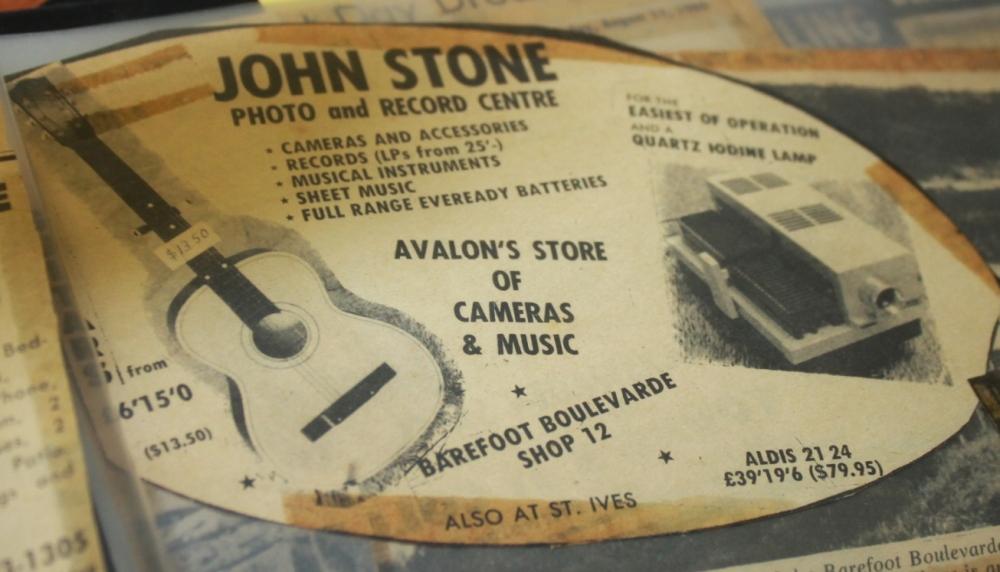
Ken Meadley joined me soon after opening in the Barefoot Bvde and he managed the retail side of the business, while I concentrated on the photography. This lasted some 15 yrs before he moved on. The first Avalon shop was the same again; photography, instruments, records, sheet music. The shop was on the outside of the building. At one stage our business was the only one paying rent. They were giving people 12 months rent free just to get them in and it wasn’t a nice feeling to be the only ones not helped so we moved around 1968 over to 68 Old Barrenjoey Road opposite the Cinema.
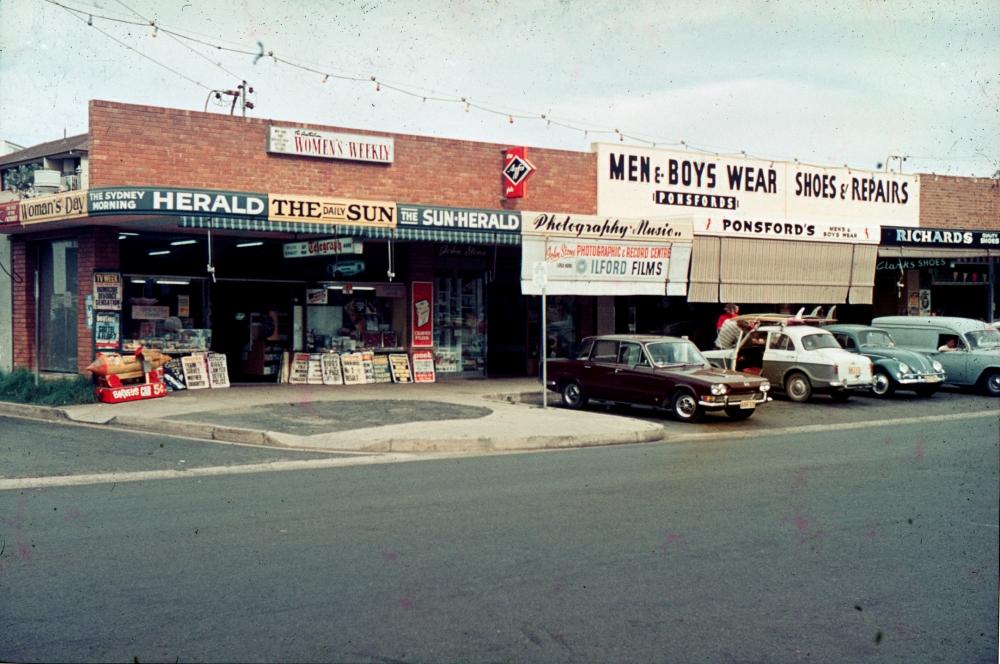
John Stone Photo and Recod Centre at 68 Old Barrenjoey Road - early 1970's
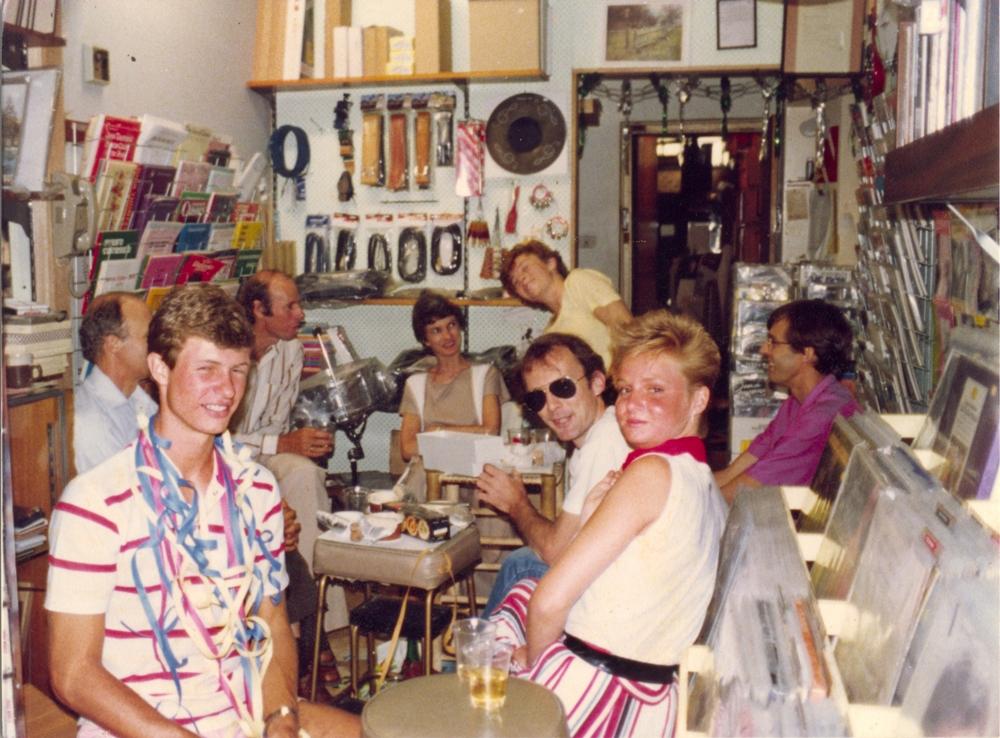
Christmas celebrations out the back of the 68 Old Barrenjoey Road business, early 1990's - John and Noelene's son Colin is at front left of picture.
We stayed in this shop until 2000. I gave up once the GST came in, I wasn’t going to go through all my stock and try and work out what the tax might be. Both music and photography hit the wall at the same time, when everything became computerised. Once the Internet came on and photography became digitised, it became free for downloading.
Even before that technology had hit these industries hard as one person would buy the DVD or CD, copy it, then give it to their friends. Same again with digital photography, once this came in all the accessories like filters, cable releases, everything associated with this that we were able to supply became obsolete. So by 2000 all these factors were taking effect and it was better to give it all away, which was a shame.
You are still working with this technology now though?
Yes. We sold the shop and I moved out the back, continuing, as I am now, to do things with the computer with old photos, to clean up and restore these. The understanding of having come through the old photographic processes has definitely helped here with that. Knowing the camera processes and how the images were made has its benefits. There are still a few places that teach all photographers, as part of their courses, the old processes.
Can we talk about your own photography – many of the wonderful images we have of this area from the 1960’s 70’s and on are yours…
I don’t know about that. I never did it on purpose. Often I was just testing a camera out that came in to the shop to find out how it works – these were some that I’d have repaired, or somebody would bring theirs in and say it wasn’t working properly, something was wrong…
And you’d go and take a photo to find out what’s wrong? How fortuitous for us all!
(Laughs)
I was also working as a Photographer – would photograph the newborn babies at Mona Vale hospital. I would photograph the nurses each year on their graduation – this would happen twice a year. The Debutante Ball at Pittwater High School each year was another. A lot of these balls were organised by Cora Adcock, who was also very active with the Mona Vale Hospital Auxiliary.
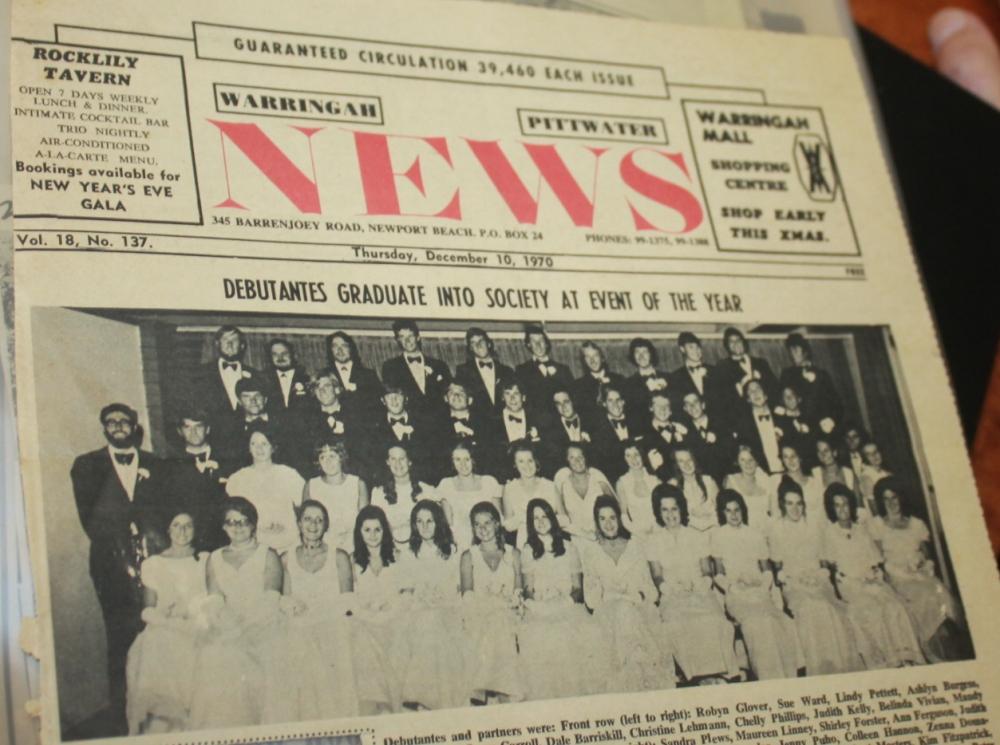
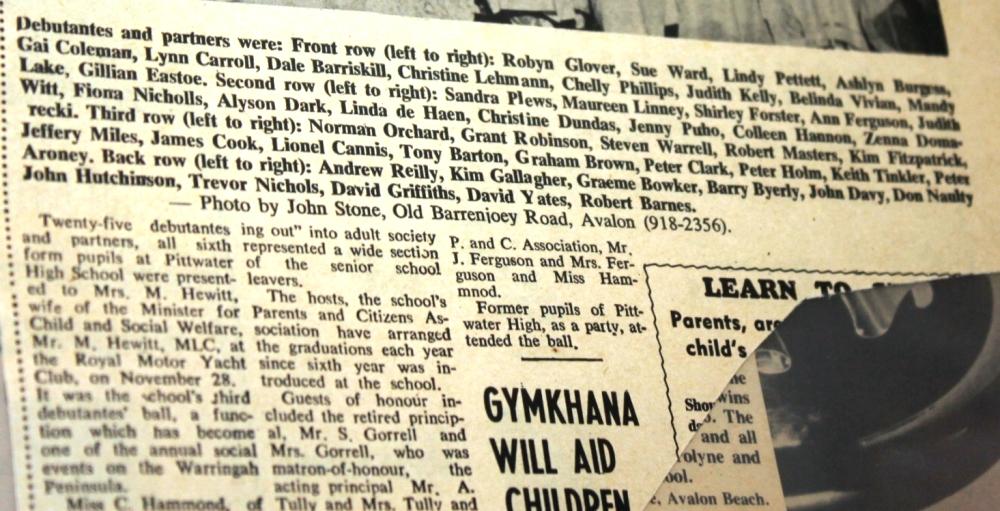
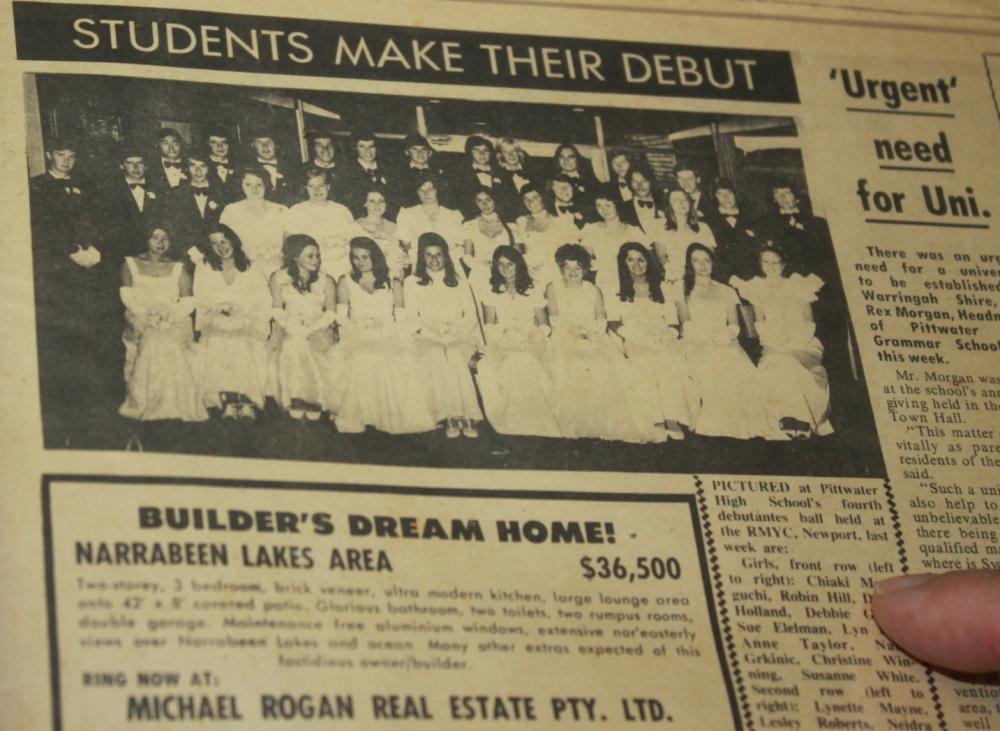
I also went into town to do a job for Tooth and Company which was originally to be 2-3 days and ended up working for them one day a week for 18 months. This was photographing ‘how to brew beer’.
Did they let you do any ‘quality taste testing’?
We would occasionally go into the Testing laboratory to try a few things out at the end of the day. I’m not a drinker so didn’t indulge that much, drinking and work don’t mix.
What other photographic assignments did you undertake?
When I first began in Avalon I did quite a bit of photography for the Pittwater News. This was a little weekly paper that worked out of offices at 345 Barrenjoey Road, Newport, and began in 1965 under Manly and Pittwater Newspapers Ltd. It had absorbed the previous Peninsula News (1957 to 1965). Rick looked after this for its first 15 years. It was eventually taken over, I think, by The North Shore Times. I have kept the clippings from this of both where we advertise the shop/s and those where the photos I took were used.
You must have met everyone?
Between the shop and doing the work for the Pittwater News I may have met most of the people living here.
Pittwater News Photos; a few examples:
Rocks on cliff face cleared at Bilgola pool – "they blasted the cliff to clear away any loose rocks. I took the photographs of them doing that.”
“They then put up a permanent fence behind Bilgola pool in case any further rocks fell, prior to this fence there had only been a net, which didn't work or wasn't safe enough.."
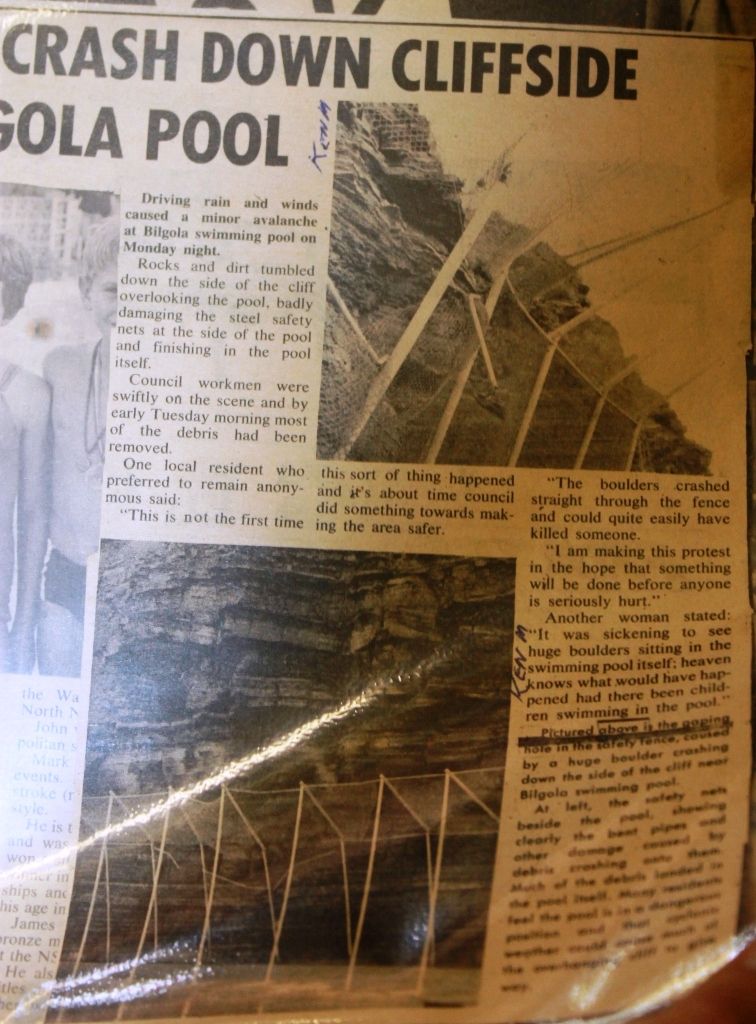
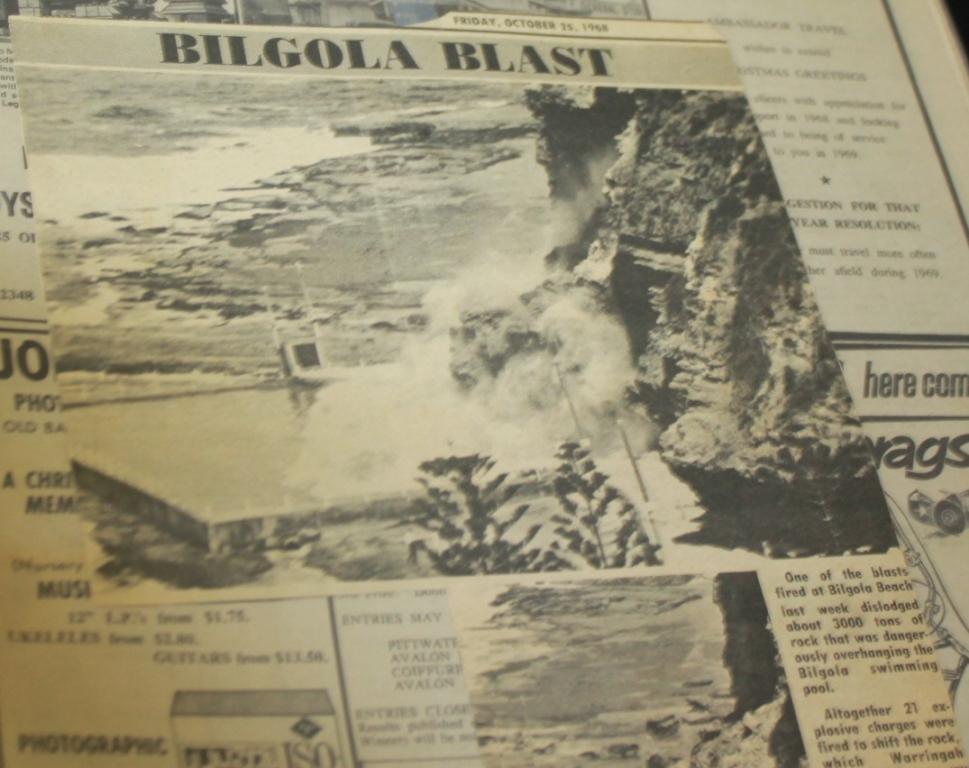
Above: Earlier article and then article with John's photograph from Pittwater News, Friday October 25, 1968 -
following this (below) - some of the sequence of photographs John Stone took recording the Bilgola Beach cliff face blasts - in the 3rd one down you can see a lady on the edge of the pool, swimming cap on, hands on hips, surveying the rubble; possibly wondering whether it's alright to have a dip...
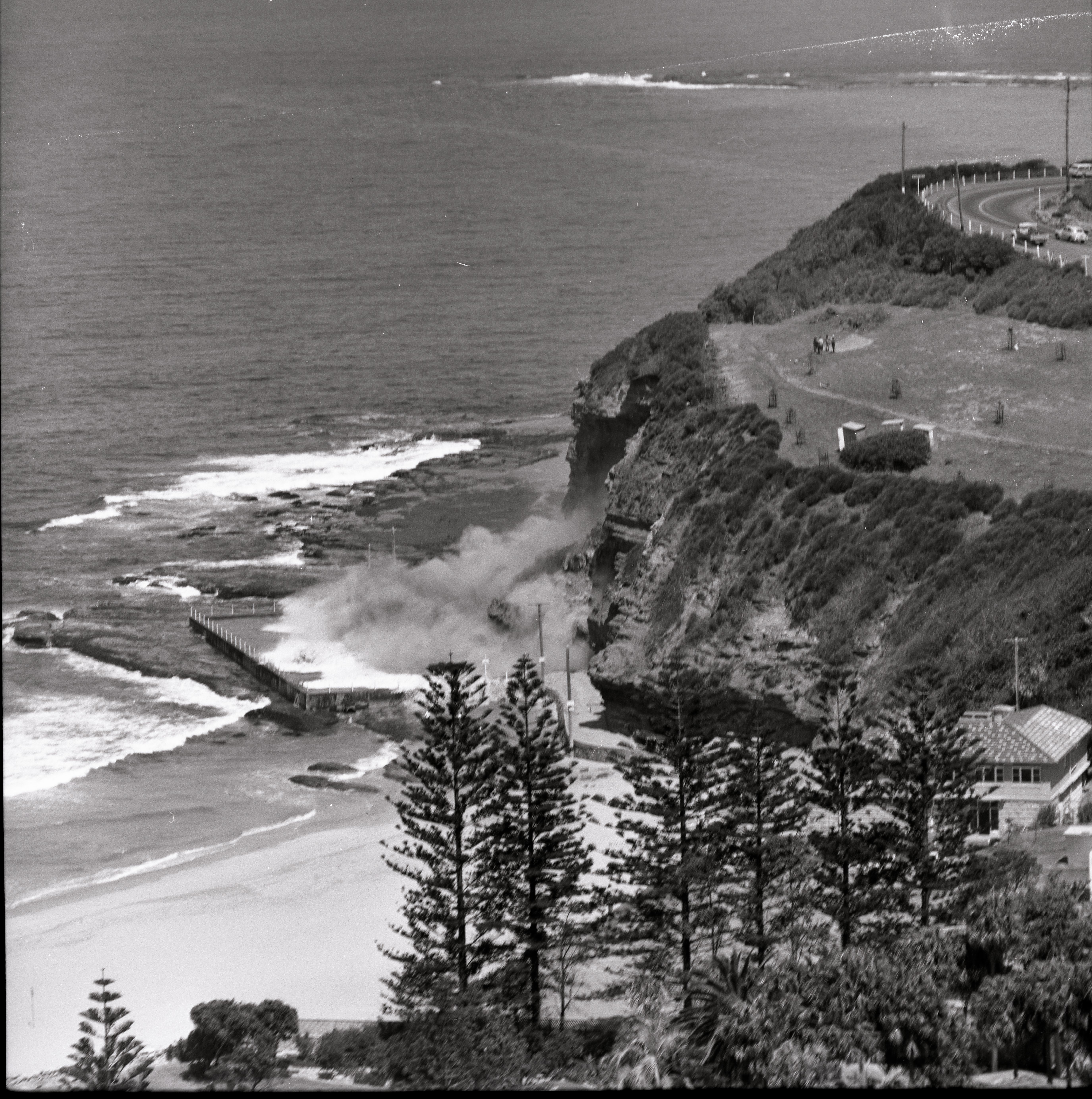
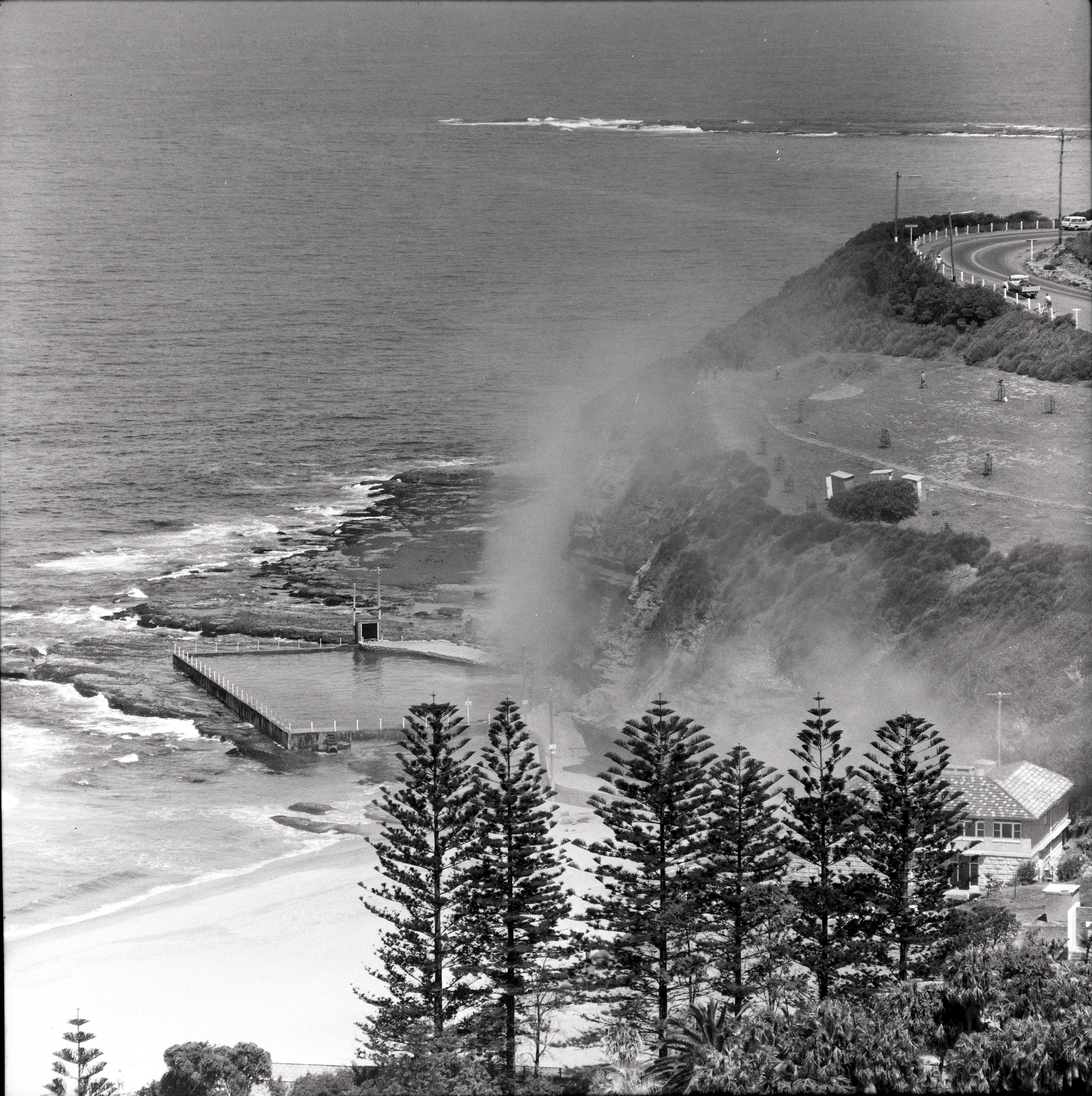
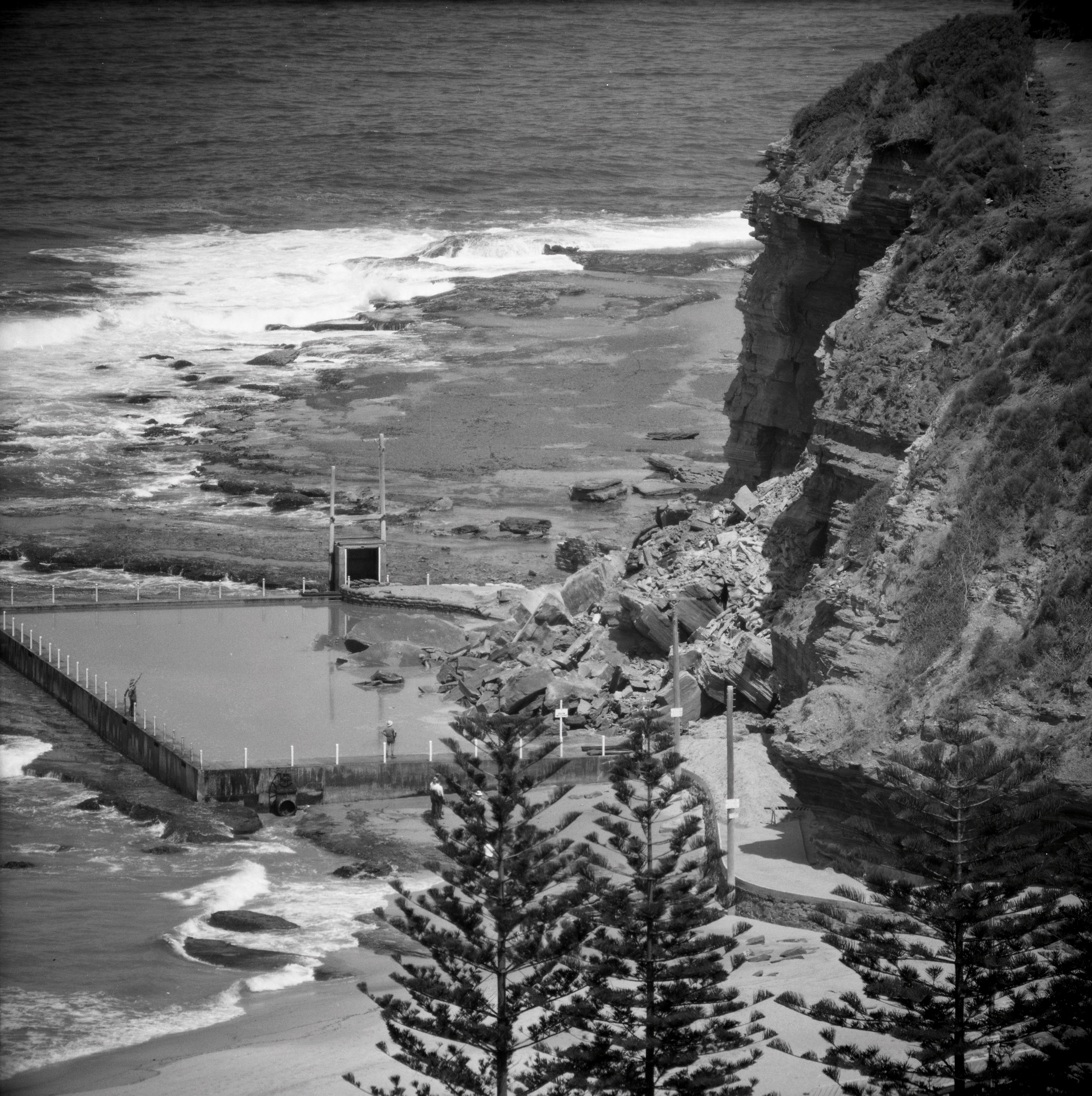
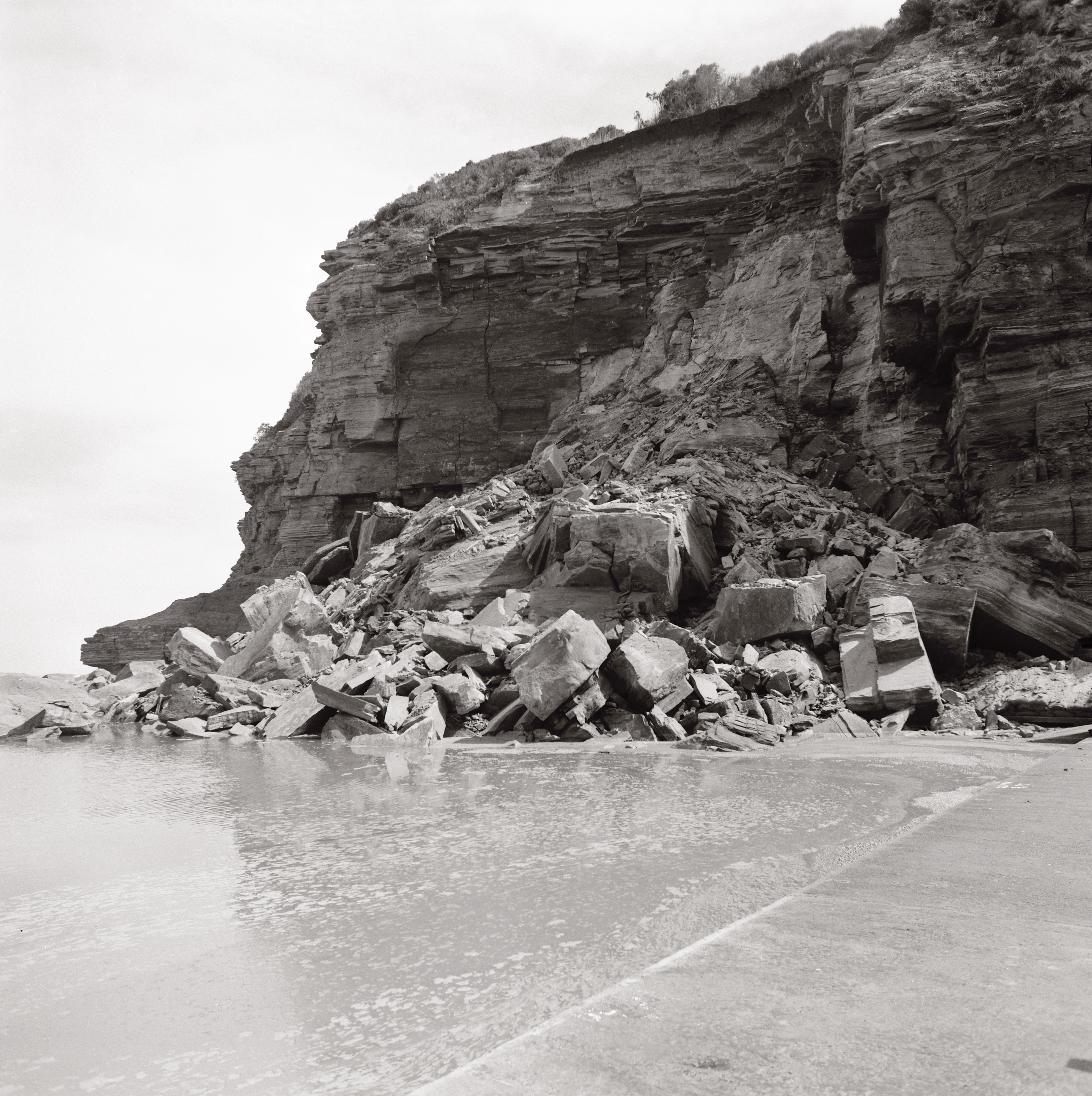
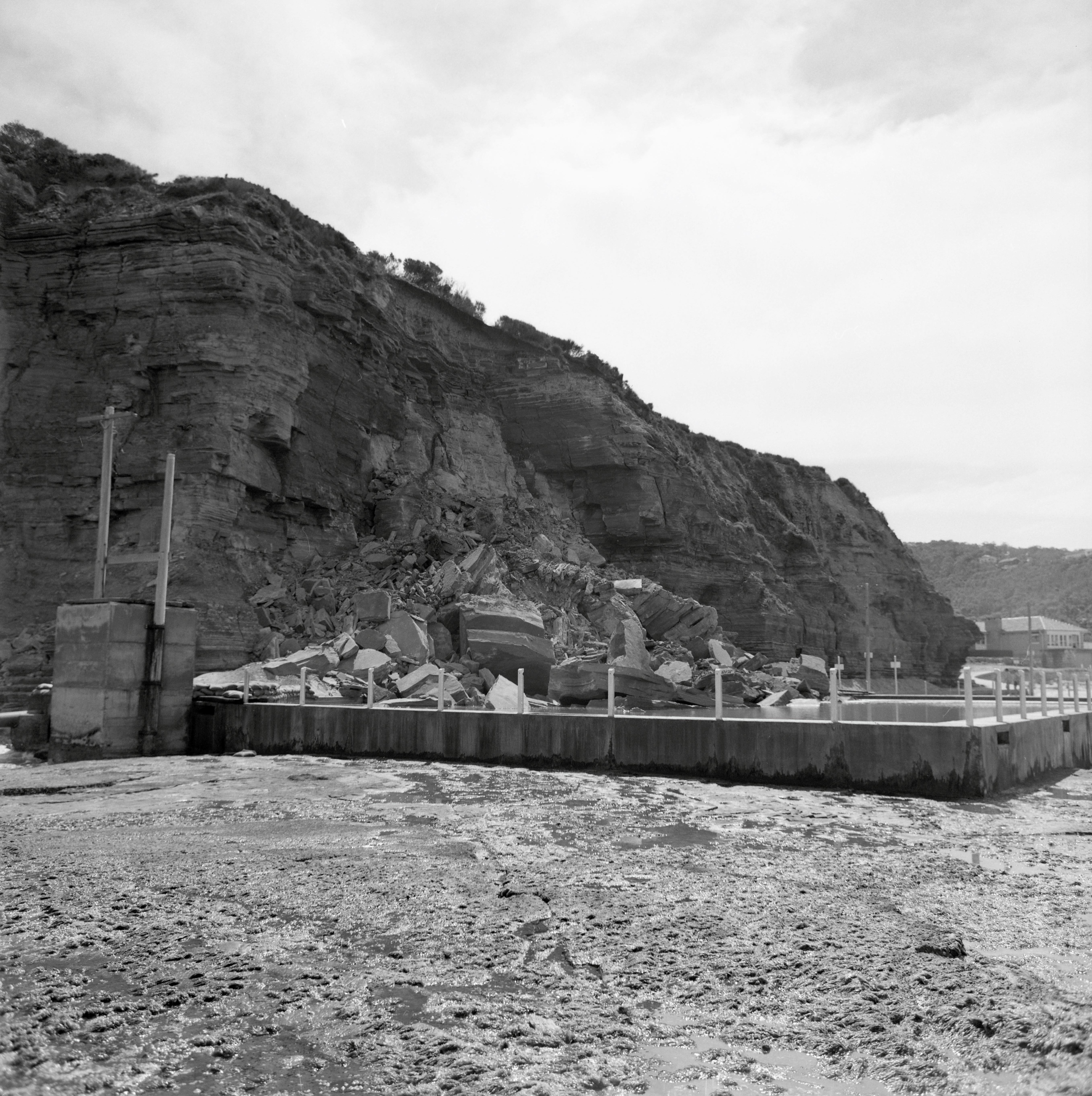
Fashion Parades at Rock Lily Tavern at Mona Vale and elsewhere - John was the photographer:
“There was a real community in those days and whenever there was a fashion parade on everybody was involved. These were run to raise funds for the hospital and other community projects. They were a popular way of doing this. ”
Koalas – 1967: "Avalon Animal Clinic would look after koalas that had been hurt. We used to look after the koalas once they had attended to them, had them in a big bird cage up the backyard.”
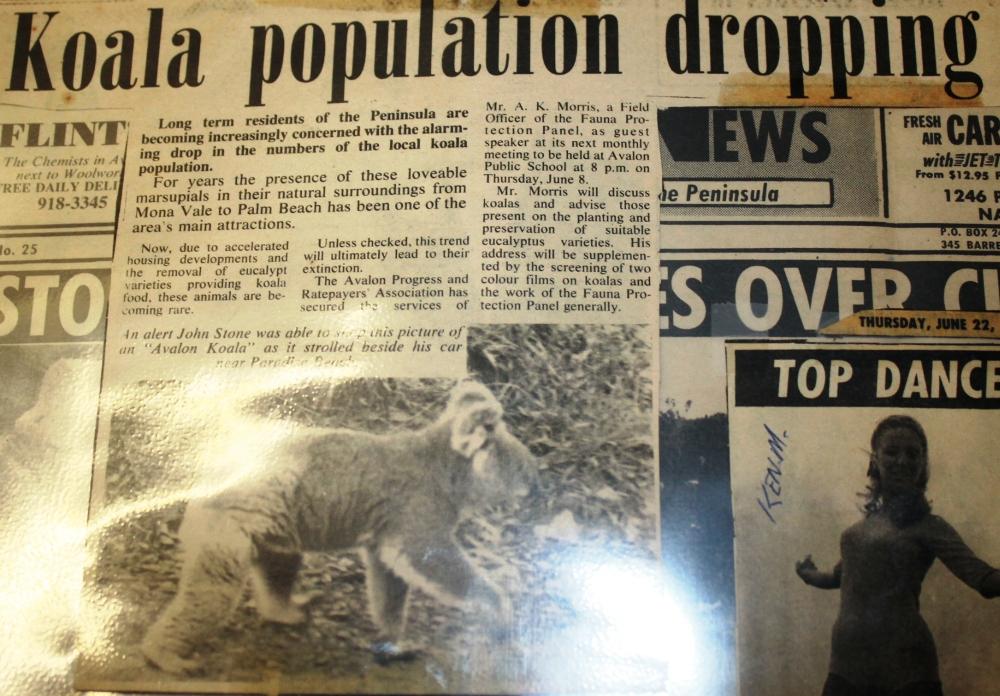
John's photo from Thursday June 1st 1967 edition of Pittwater News - the caption reads 'An alert John Stone was able to snap this picture of an "Avalon koala" as it strolled beside his car near Paradise Beach.'
John remembers photographing a car over cliff, Local football, Gym classes at Mona Vale, a surf boat that had to be towed back to Newport SLSC – from Bilgola incident, Avalon Lions Club events, among many other community events (John is in this one, he was Treasurer for a while and recalls the Avalon Lions Club would organise, among any other community building events, a fishing contest and photographing some of the aboriginal children from Brewarrina coming down for a week of fun in the sun on the beach (Narrabeen and South Narrabeen). Avalon Lions Club were very much involved in the beginnings of this.
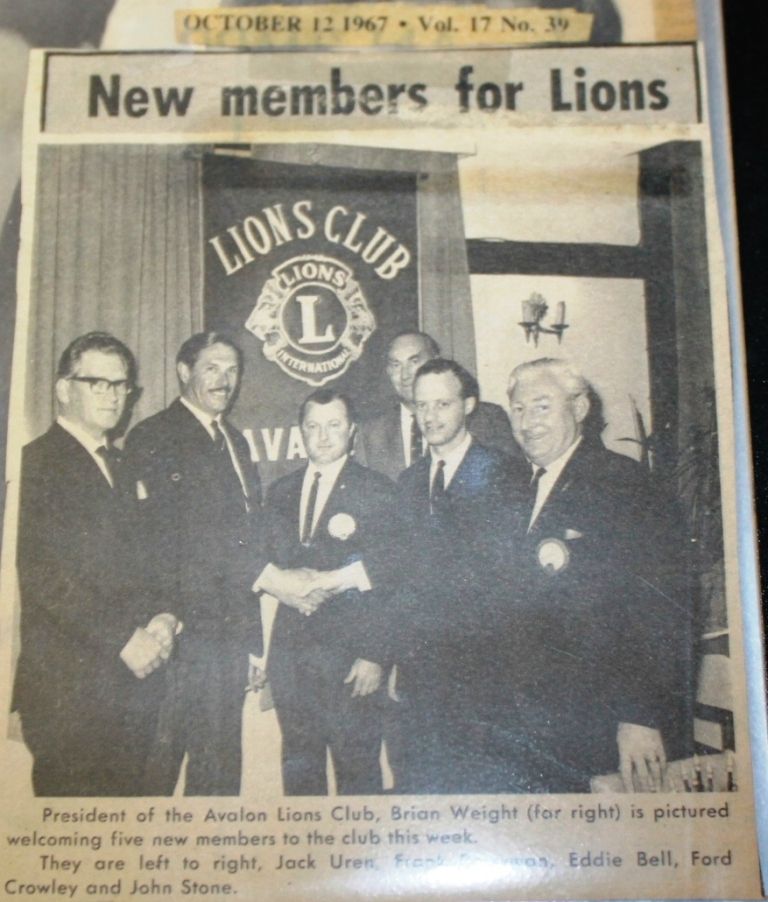
John is second from right - Pittwater News, October 12th, 1967
There are also photographs John took of Jackie Weaver and Lisa Goddard – Channel 2 comes to Pittwater! – from November 1967, and some wonderful images in a Brochure done for Bayview’s Loquat Valley School.
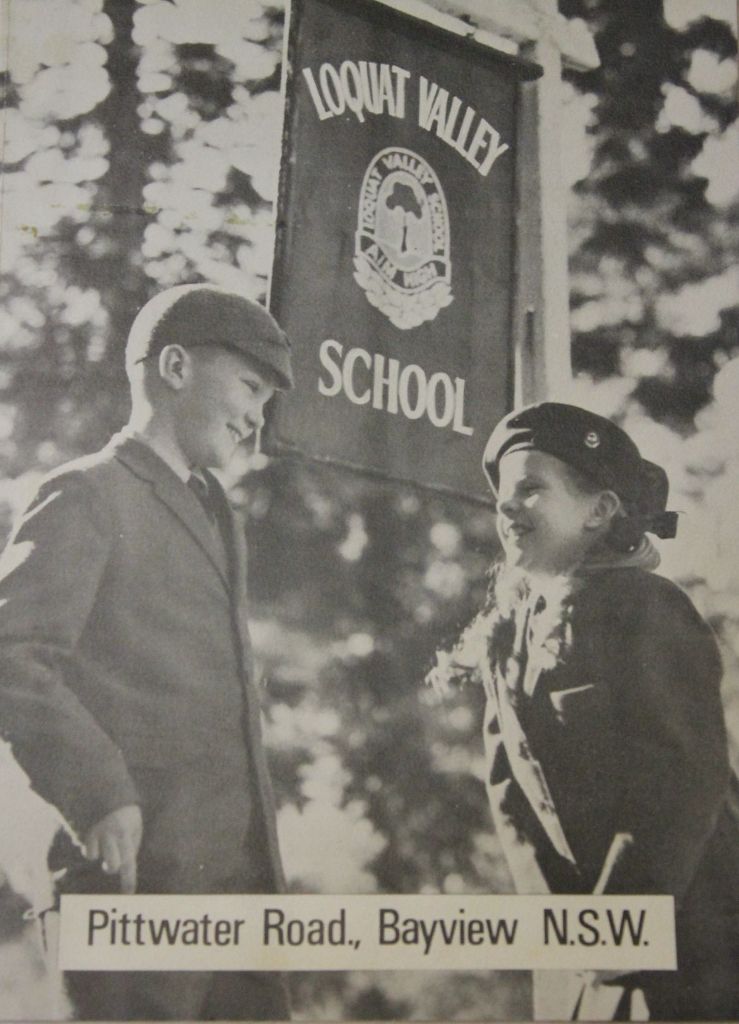
One of John Stone's photographs for the Loquat Valley School brochure.
The original and first Golden Bowl at Avalon Bowling Club is among this collection of Pittwater News articles, President of the Palm Beach Avalon Beach Women’s Auxiliary for Mona Vale Hospital – (Mrs. Jeffries, Ramsay, Coles, Gates McKenzie, Poole), the Church Point Cemetery before all the headstones were moved, Annual Rotary Changeover Meetings, the Avalon Beach RSL: John photographed the changes over the years, including the naming of the different rooms.
The ANZAC Day Commemorative Services – “one of these from 1968 is a favourite. These are Pittwater High School they had Cadets at that stage.”
“This later one, in colour, was photographed from the roof of the shop, John Stone Photo & Record Centre, in Old Barrenjoey Road, Avalon.”
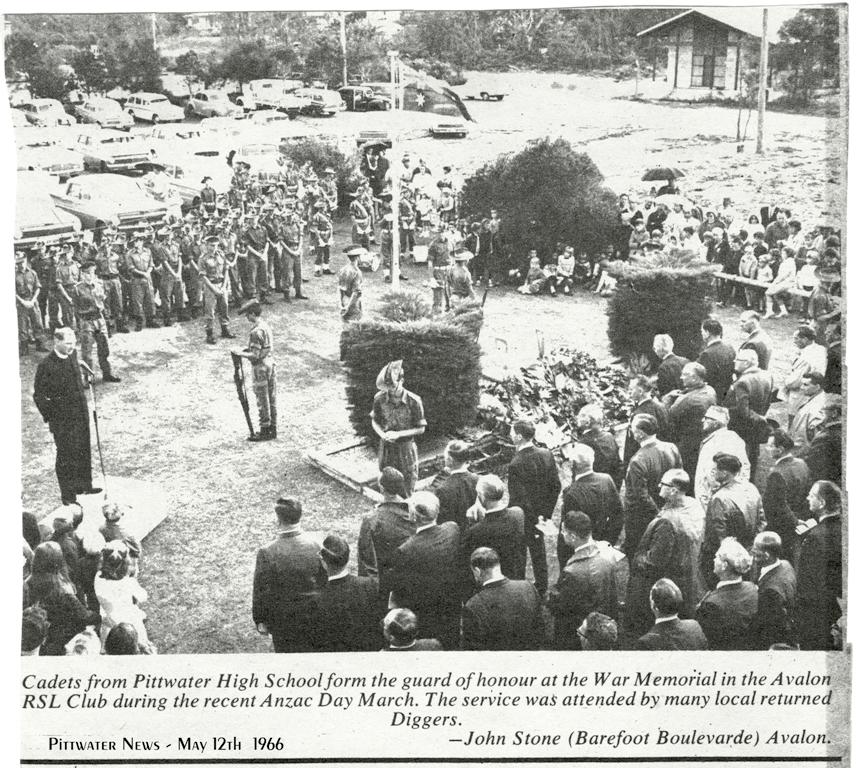
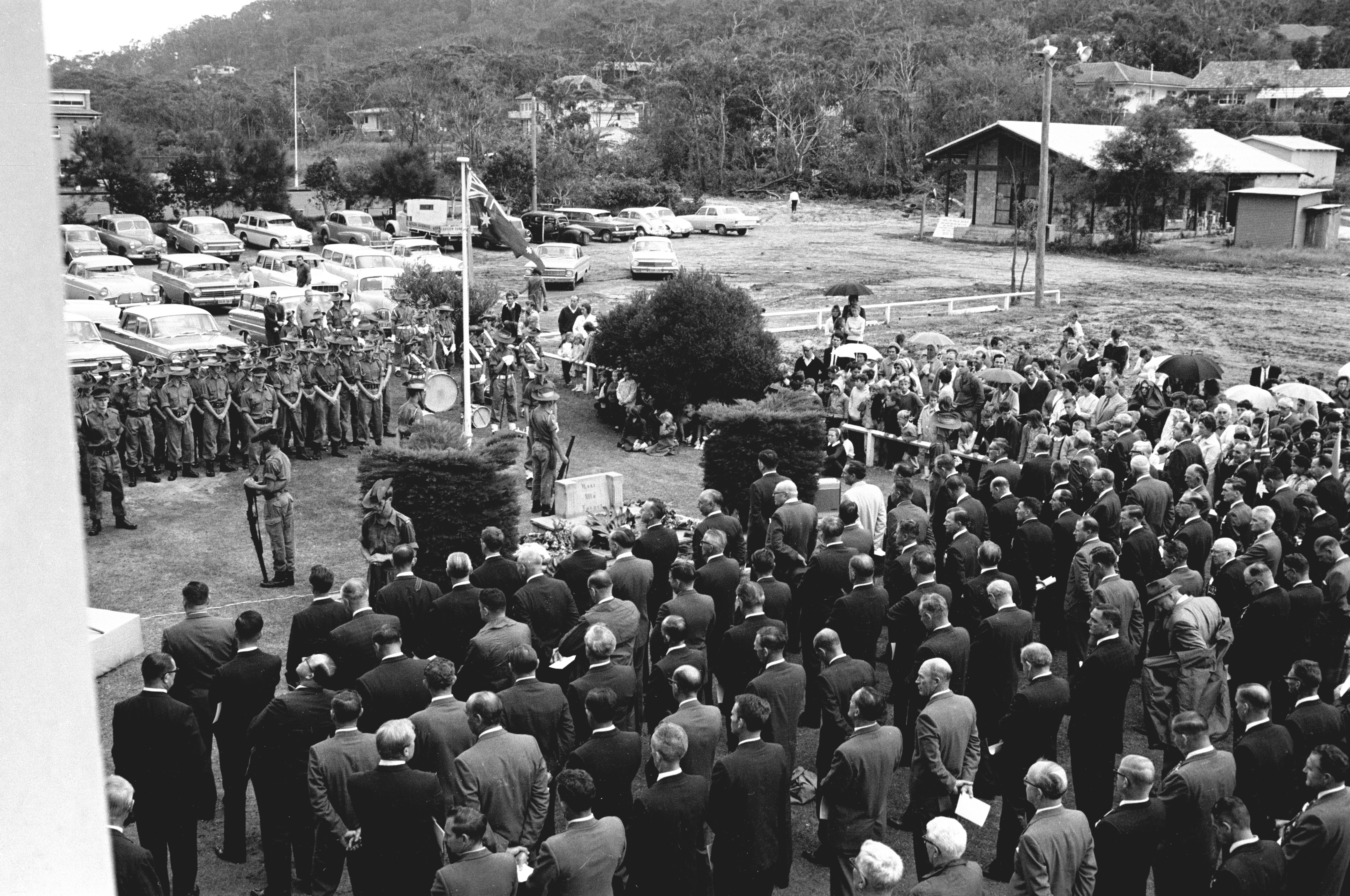
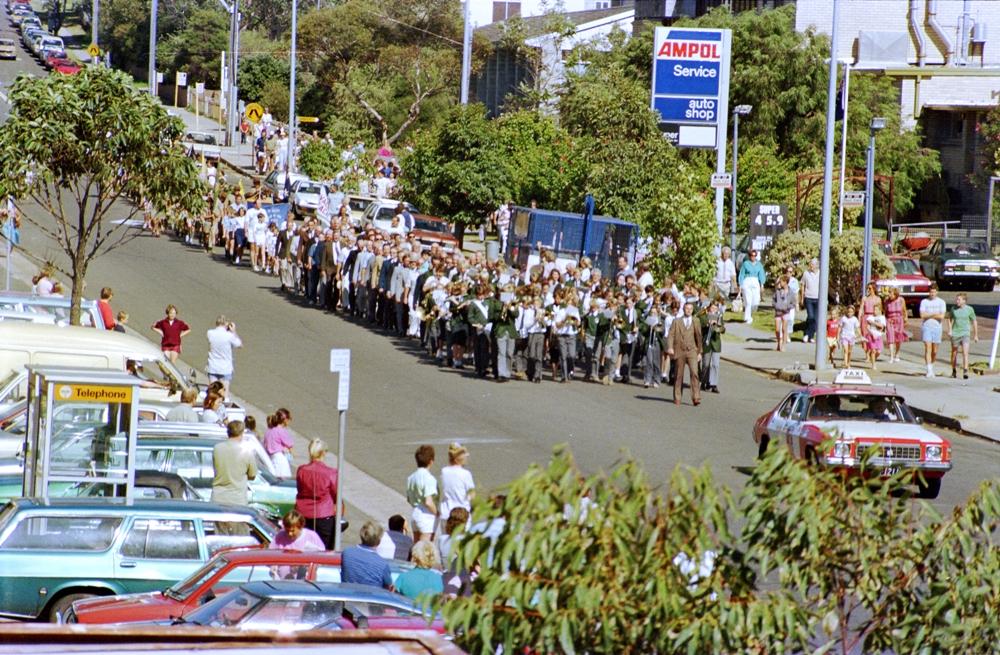
What is your favourite camera out of all those you worked with?
The Nikon F series was the main camera I used. One of my best mates, Graeme Stuart, was a Rep. for Nikon, which os course swayeds me towards Nikon as he could provide up to date Information on new products and advances.
What is your favourite out of all those photographs you took during this time?
I couldn’t nominate any single one – there was all the horse jumping, that was great, especially when you got some beautiful action shots with the horses.
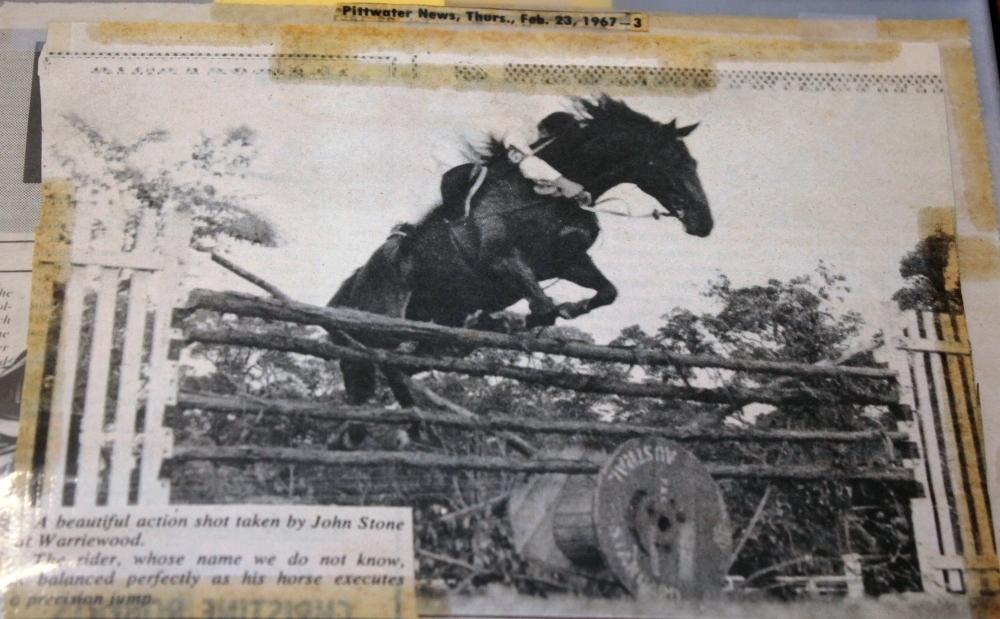
Pittwater News - Thursday February 23rd, 1967
I liked taking the landscapes too, those at Avalon, Careel Bay. This one at North Avalon is popular- with this it’s actually five photographs that I’ve joined together. If you look closely you can see where it’s been joined.

John Stone - Avalon Beach Panorama - 1966 - and a few sections from:
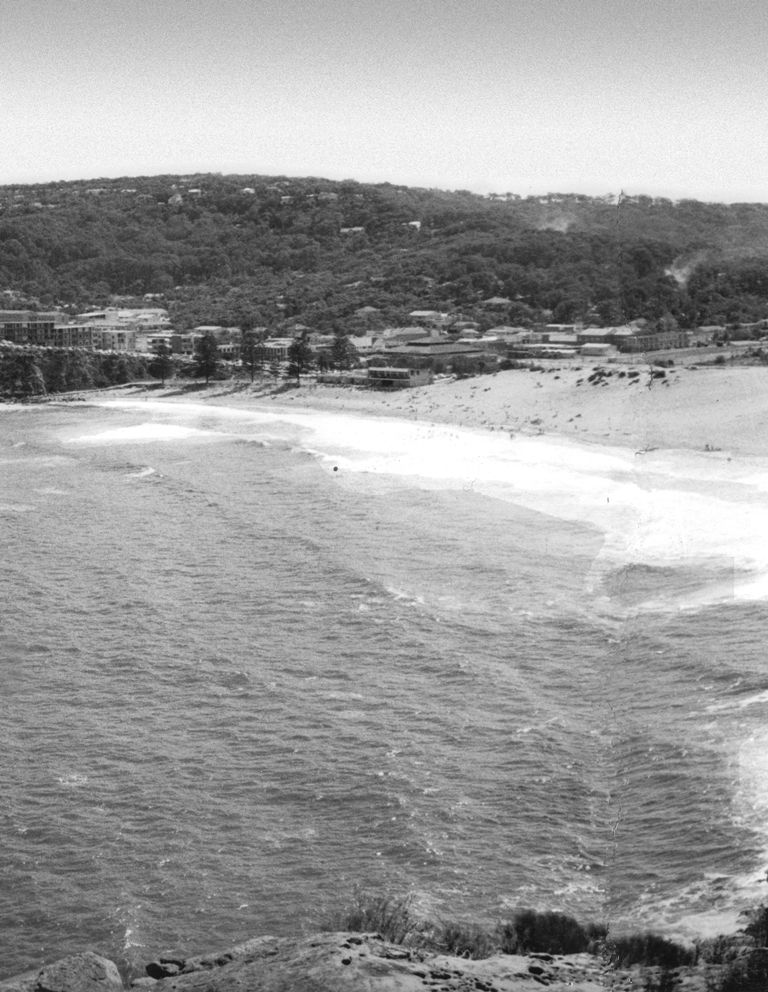
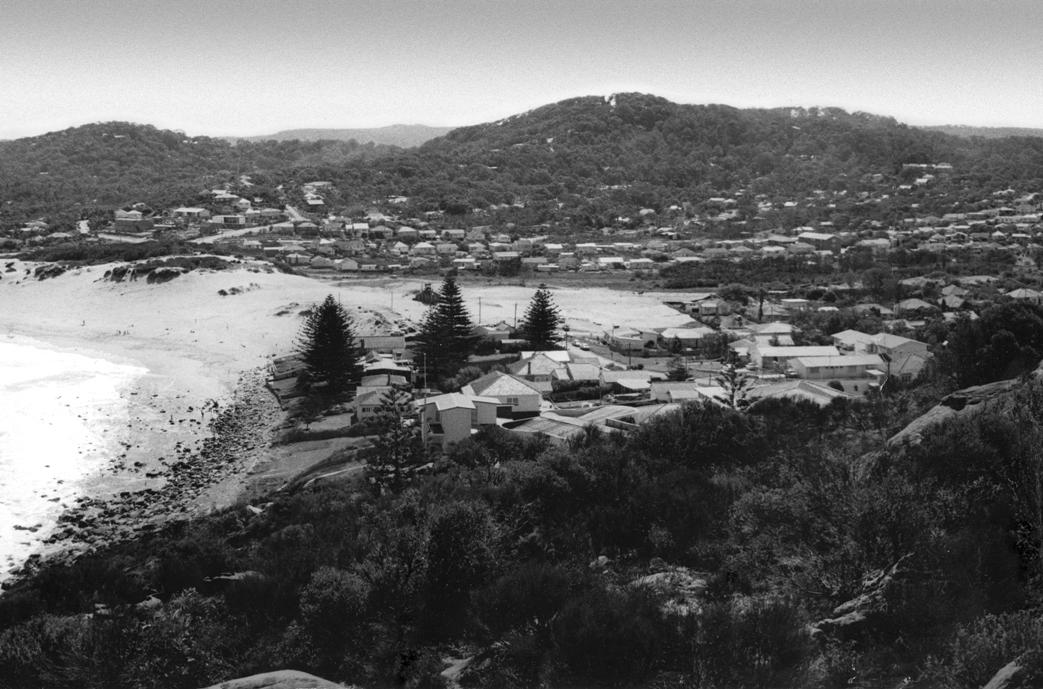
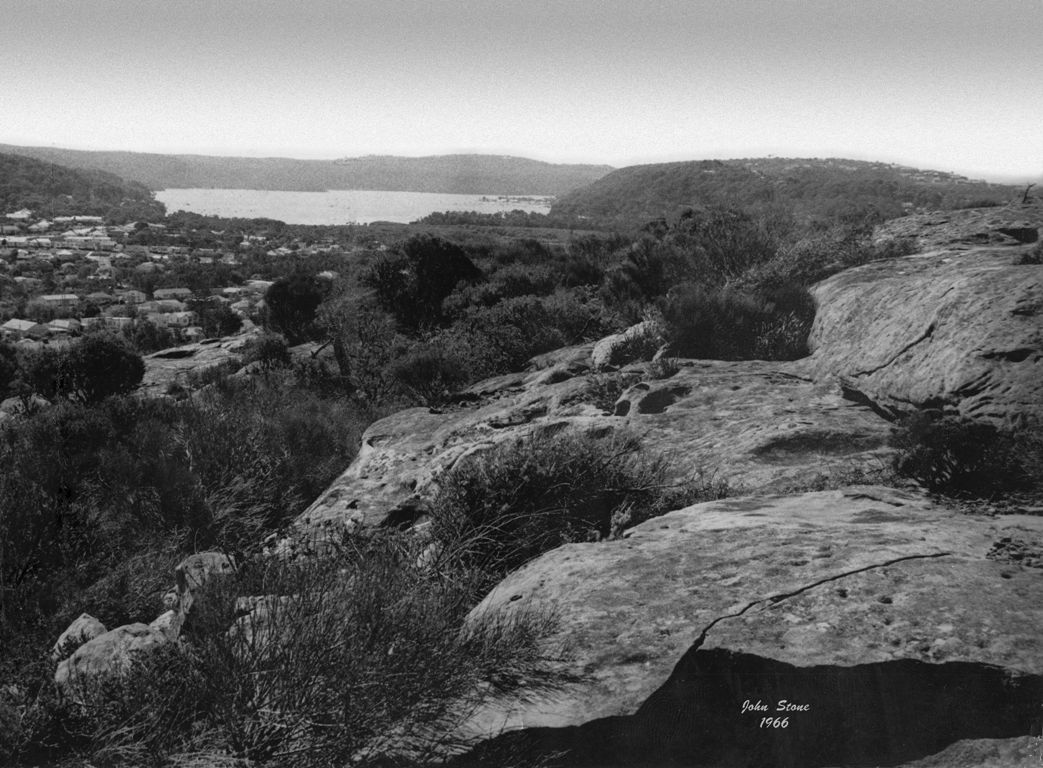
You also get to take images that show changes here – the Torpedo station at Taylors Point for example, or this one at Barrenjoey from 1974 – there’s changes there too.
I photographed the Avalon sandhills being removed by Shaws before this was stopped. This happened at Mona Vale too. The Avalon Preservation people began all that, saving the dunes, and North Avalon. Mrs. C J Adams was behind this and is remembered very fondly by many of us here for all the work she did. Mrs. Adams did a lot of things locally but that was probably the biggest.
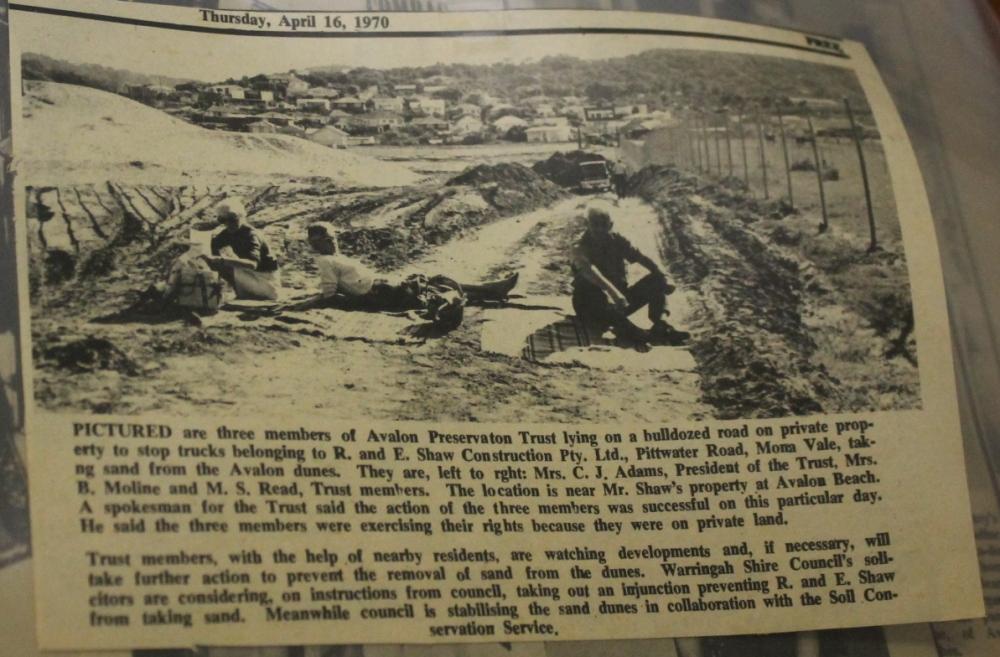
Johns Photo: from Pittwater News article of Thursday April 16, 1970
One of my favourites from around here is this one taken at Locquat Valley School, Bayview. I’d been asked to do photographs for a brochure for the Loquat Valley school. This child had been affected by Thalidomide – which resulted in children being born without arms. This was taken in 1977.
For me it’s a beautiful picture and also captures some of the history of what the young children went through then.
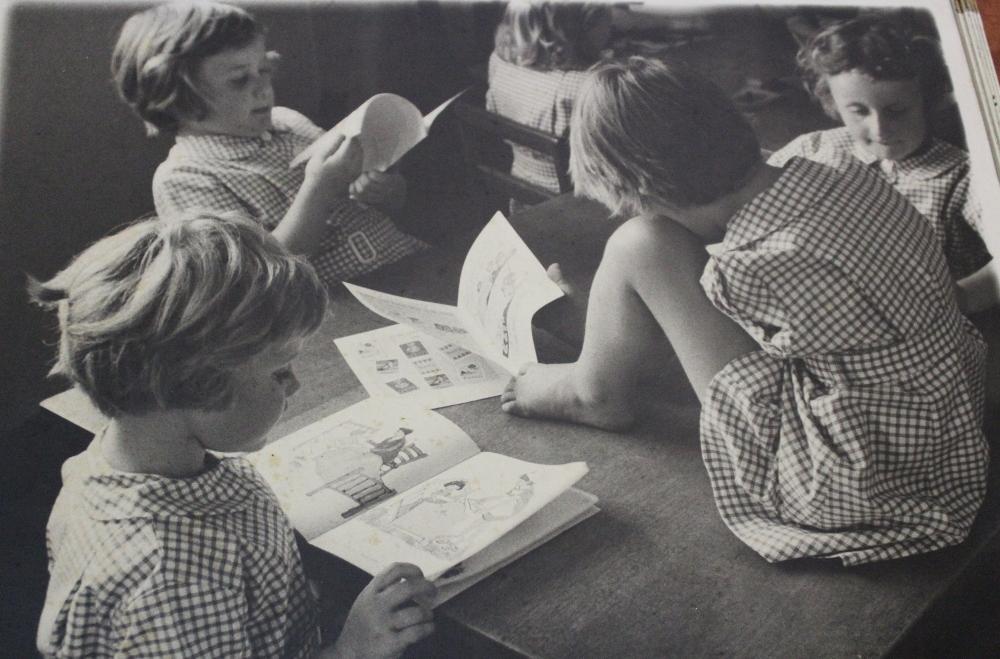
John Stone photograph - 1977 - taken when doing assignment for the Locquat Valley School brochure.
There was another young fellow in Avalon, lived at the end of Avalon Parade. He attended Avalon Primary school and at one stage they gave him metal arms but then had to take them off because he kept pinching everybody, bit of scallywag he was. He attended Cubs, would come down to Paradise Beach on Pittwater on a scooter, leaning with his shoulders against the steering handle going down, full pelt. We would marvel that he didn’t hurt himself, he was fearless.
My favourites were always those photographs of people where something was communicated.
I enjoyed using another camera, which took panoramas. This series, taken with this camera, which was faulty and I fiddled with it, took some great pictures. The lens would twist around. I found this in a box of rubbish someone had thrown out; it didn’t work but I got it going well enough to get a few images. It’s a Russian camera, this spins around, and they were numbered, each camera made. I used 35mm film in this one, which you thread around the barrel.
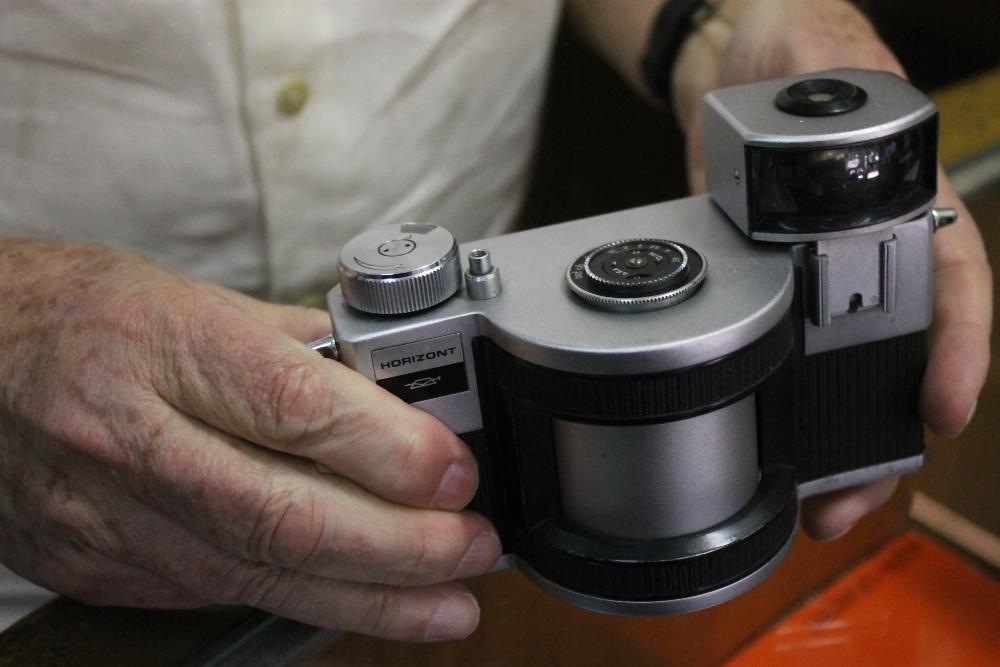
The HORIZONT panorama camera - see Avalon Beach panorama above.
You also collect cameras?
I’ve collected cameras all my life, it’s only now that we can have them out here in this space so people can enjoy them a bit. I would put them out once or twice a year when we had the shop if there was a Market Day on, or something similar, so people could see them. People still keep bringing them into me here.
The Box cameras are the most popular section, possibly because people remember them or remember their mum and dad using them. The others here, although more unusual and with great stories behind each, don’t attract the same interest because people aren’t familiar with them.
Which camera among these is you favourite?
This 500mm for 120 film format, which was a Bronica, the Japanese version of the Hasselblad, this has a Nikon lens as they were supplied with the Nikon lens initially. This was the only one brought into Australia. Zenza lenses are used now.
It looks like you could photograph people walking on the moon with that lens?
No, it’s only a 500mm lens. This shows you how long these were in earlier days compared to those that have longer range now but the barrel of the lens is much shorter.
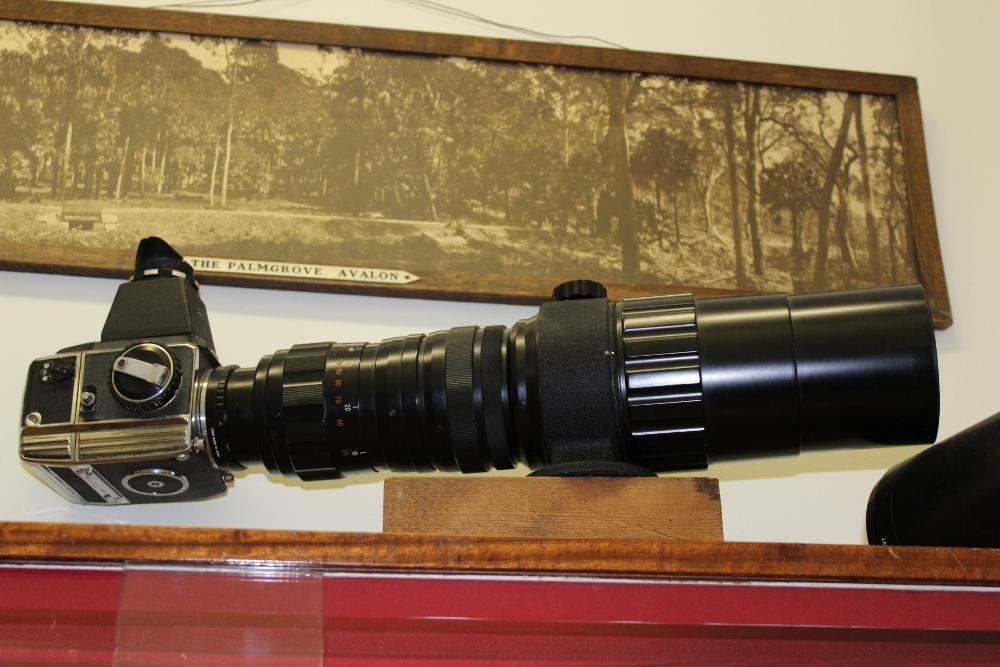
Photo shows the BRONICA with it's 500mm Nikon lens.
How did you meet your wife?
My wife Noelene is a country girl from Bathurst who worked as a nurse with my sister at the Royal Prince Alfred Hospital. One weekend she had nothing to do so my sister said ‘come down to our place at Paradise Beach (Clareville)’ and the rest is history, you may say.
Your family had a place at Paradise Beach?
Yes, that’s where we are still. While we were living in Strathfield mum and dad bought a place on Paradise Beach. They’d come down to see Alec & Olga Root (parents of Keith), who had a place right on Paradise Beach. Dad liked it so he made inquiries and found our place – this was 1959.
When we married, 1st of August 1964 at Bathurst in the Methodist church, we bought a block of land on Wandeen road which looked right down the estuary to Lion Island. We were getting ready to build there but then dad got really ill and mum and dad said we should buy their place on Paradise Beach as they wouldn't be using it as much as they had in the past. We sold Wandeen, fixed up the place on Paradise, and have been at the old place ever since.
How many children and grandchildren do you have John?
Two children, Colin and Lyn, and three grandchildren, Skye, Ganan & Kai – my sons two are aged 12 and 11 and my daughter’s boy is almost 6.
You spend a lot of time now archiving old images for the Avalon Beach Historical Society. Do you like doing this still?
Yes, it’s all part of the different things you may do in the field of photography. I started doing this while we still had the Old Barrenjoey road shop, and I love the history involved, so I’ve continued on.
I still do photograph repairs and restorations and enlargements for customers here as well, the only local outlet to do that.
So people can contact you if they have an old photo they want restored?
Yes. I’m in the shop three days a week or they can call at other times (0427 070 309).
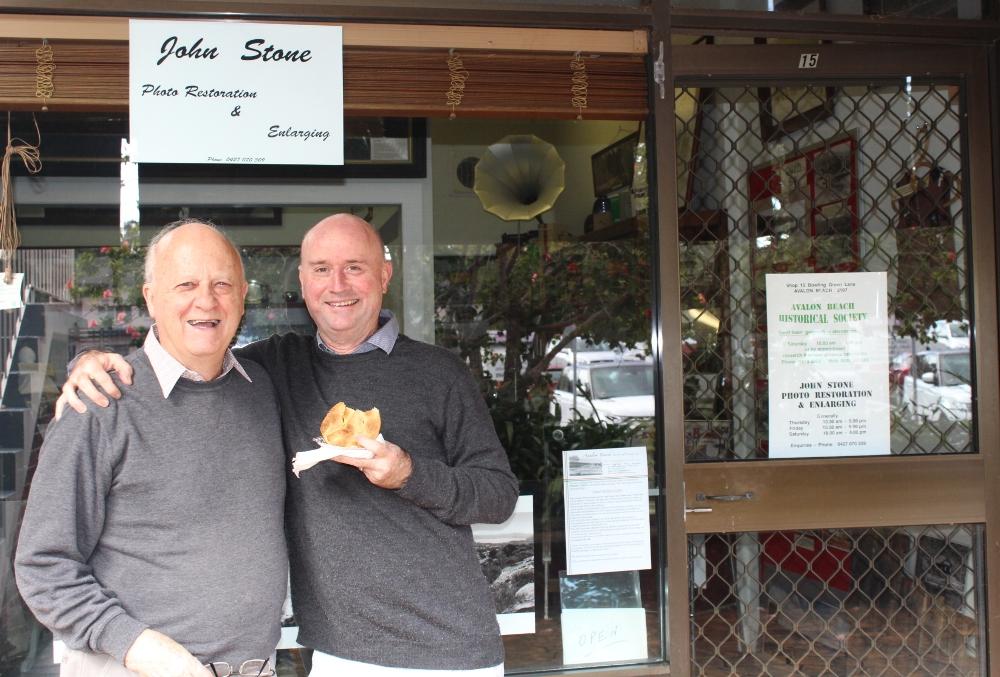
John and mate mucking about outside current Bowling Green Lane, Avalon Beach premises.
What are your favourite places in Pittwater and why?
Pretty well all of Pittwater. Most of the inlets and beaches have their own feel. Paradise Beach is home obviously, so there. I have a little place in the country at Penrose and love going there too though. So I’m lucky – I have the best of both worlds.
What is your ‘motto for life’ or a favourite phrase you try to live by?
I get a great sense of enjoyment in providing a service that people want and get a lot from. You have to be able to enjoy what you’re doing, and when it brings others happiness, in providing restored photographs, or in doing photography, it affirms following your passion and doing your work well.
Notes
The Seven Network began as a group of independent stations in Sydney, Melbourne, Brisbane, Adelaide and Perth. HSV-7 Melbourne, licensed to The Herald and Weekly Times Ltd (owners of two local papers at the time, The Herald and The Sun), was the first station in the country to use the VHF7 frequency. It launched on 4 November 1956, soon joined on 2 December by ATN-7 in Sydney, owned by Fairfax subsidiary Amalgamated Television Services.
TCN-9 launched on 16 September 1956. John Godson introduced the station and Bruce Gyngell presented the first programme, This Is Television (so becoming the first person to appear on Australian television). Later that year, GTV-9 in Melbourne commenced transmissions to broadcast the 1956 Summer Olympics, later forming the National Television Network alongside QTQ-9 in Brisbane in 1959 and NWS-9 in Adelaide, the basis of the current Nine Network, in 1959.
Television Arouses Interest in Penrith
Much interest has been taken in the television test transmissions commenced at Handley's shoowrooms, 493 High St., Penrith, on Friday and continued daily this week.
T.C.N. Channel 9 has been transmitting very clearly slide "stills", "test patterns'* and sound recordings each week day, times being from 10 to II a.m., 3.30 to 5 p.m., 6 to 7.30 p.m., extending to 9 p.m.
Very clear signals and "still" pictures have been coming through.
DOCUMENTARY FILMS SHORTLY
The firm is looking forward to showing documentary films very shortly.
Quite a lot of interest is being shown in the transmissions and large crowds congregate for each session. Television Arouses Interest in Penrith (1956, July 19). Nepean Times (Penrith, NSW : 1882 - 1962), , p. 1. Retrieved from http://nla.gov.au/nla.news-article101358219
Far West Children's Health Scheme
Two sets of twins are among the 150 outback children who are now avidly looking forward to the Far West Annual Camp. These children were chosen from many whose qualifications were carefully considered before the final decision was made at the headquarters of the Scheme in Manly.
Qualifications for attendance arc as follows :- Children must be between 10 and 12 years, live more than 300 miles from Sydney, not before have seen the sea.
Throughout the year Far West Welfare Officers, Baby Health Clinic Sisters, Headmasters of public schools and other executive people keep an eye out in the country for children who look as if they need a holiday and whose parents probably could not afford sending them all the way down to Sydney for a change by the seaside.
The children will be brought to Sydney from as far afield as Tibooburra in the "corner" of N.S.W., Wilcannia, Bourke and Broken Hill. Far West Clinic Sisters, Transport Officers and many voluntary helpers will travel _ with the children on trains free of cost. The children will arrive on Saturday, December 29, and Sunday, December 30, and depart on January 20.
CAMPERS TO BE TELEVISED
The Superintendent of the Scheme, Mr. J. Ness, will again be in charge of the Camp and invitations have already been received for the campers to visit Luna Park and various other places of interest. One of these is for the campers to visit the new television station, ATN, Channel 7, at Epping, when part of the colour film "A Dream Come True" will be televised.
Medical and dental examinations will be held to check each camper's condition and to give all the attention necessary to their teeth.
As the main aim of all such camps is to give the children from outback areas as much opportunity as possible of benefitting from the change to the sea they will spend a considerable portion of each day on the Manly beaches and in the surf.
As may readily be understood, all this entails a lot of expense and also needs much organising. The Manly Public School has to be converted into a camp, people found to do various jobs and food and equipment supplied.
Far West Children's Health Scheme (1956, November 30). Western Herald (Bourke, NSW : 1887 - 1970), p. 10. Retrieved fromhttp://nla.gov.au/nla.news-article104015860
The Shirley Abicair Show is an Australian television variety series which aired in 1958.
The series was produced with the intention of running for nine episodes. Two of the episodes were produced and aired live in Melbourne by station GTV-9, the other seven were produced in Sydney by station ATN-7. In Melbourne it occupied the time-slot previously held by The Astor Show.
Apart from Abicair, other performers who made appearances during the run of the series included singer Jimmy Parkinson, singer Bill McCormack, singer Toni Lamond, singer Ted Hamilton, harmonica group The Three Winds, vocal group The Moontones, violinist Maurice Stead, Arthur Duncan, singer Bill French, The Tunetwisters, Graeme Bell and Bill Newman.
STARS OF THE AIR. POP SINGER IS OUTDOOR GIRL
DURING the A.B.C.’s Youth Week (December 11-17), young "pop" singer, Shirley Abicair is to be the guest artist in Hit Parade on Wednesday, December 14, at 7.15 p.m. (Interstate network). Her work impressed Tommy Trinder, who has promised to help her when she goes abroad next year.
Before starting on her stage and radio career, Shirley, who is Victorian-born, did photographic modelling. Her big broadcasting chance came when she was voted "Miss Entertainment" in the "Miss Australia" contest last year and gained a commercial radio contract. For three months she sang four songs a week over the air. Folk songs in French, Italian and Irish are her specialty, and for study and pleasure she collects Continental discs. At the present time she is doing stage and radio work as she wants to perfect her technique in both mediums. This year she has been studying dramatic art.
To accompany her singing she is learning the piano. Already she can accompany herself on the guitar and the ukelele. Shirley designs her own clothes and makes them when time permits. She likes cooking — especially Continental dishes — and has a most attractive collection of recipes. An outdoor sports girl, she loves rowing, yachting, fishing, riding, tennis and swimming — in fact, most outdoor sports. STARS OF THE AIR. (1950, January 12).Balonne Beacon (St. George, Qld. : 1909 - 1954), , p. 12. Retrieved from http://nla.gov.au/nla.news-article215370497
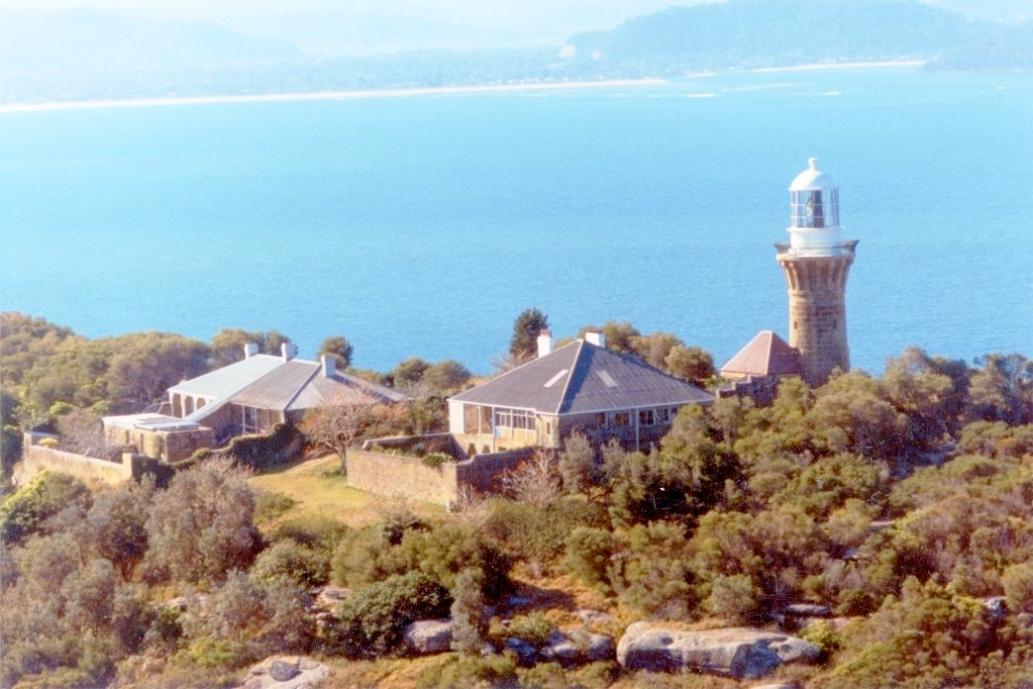
John Stone photograph of Barrenjoey Lighthouse and cottages, taken in early 1970's from a plane flown by Mr. Walton, Palm Beach Boathouse.
Copyright John W. Stone, 2016.